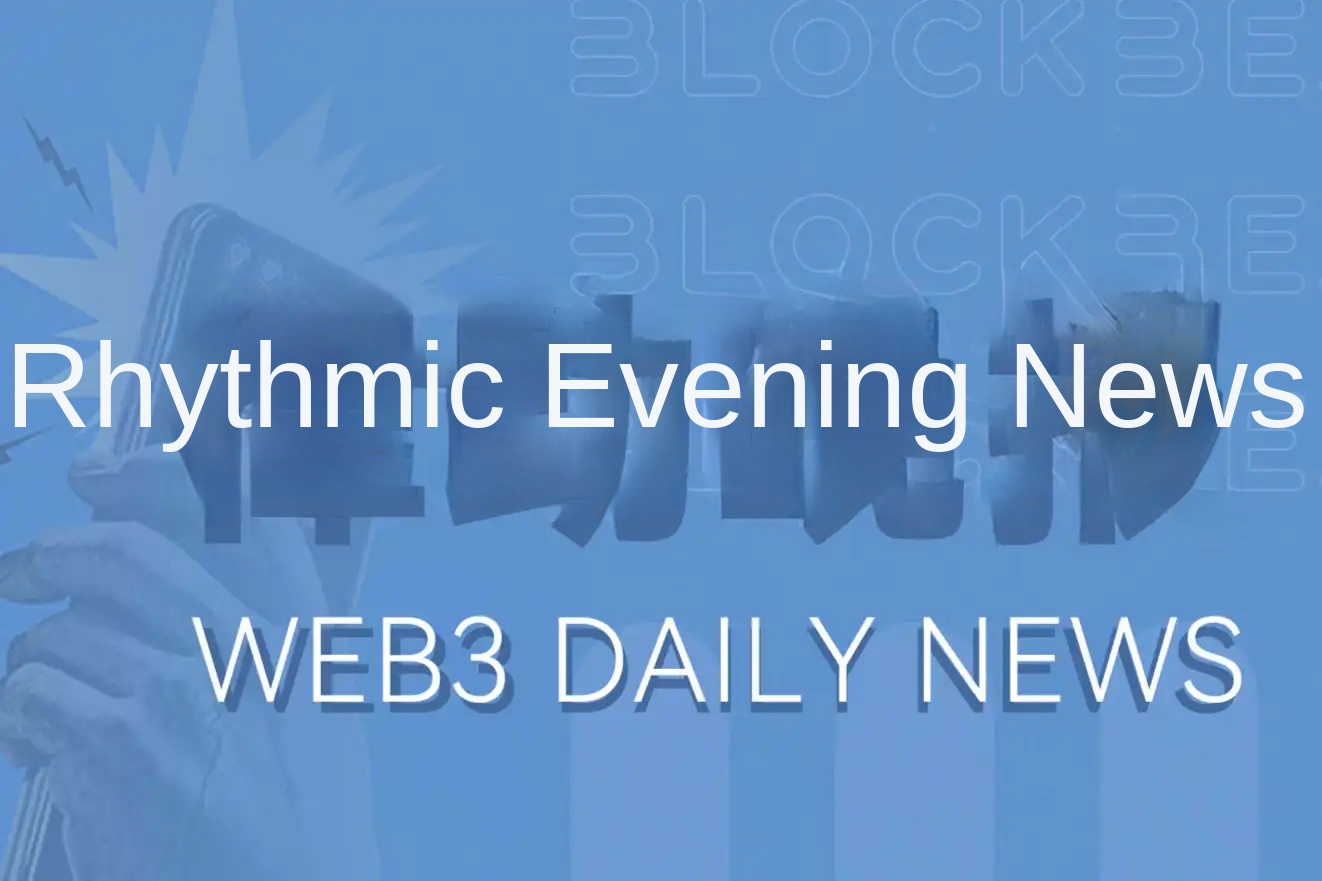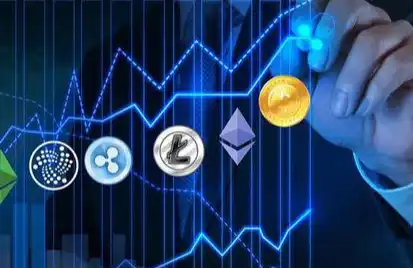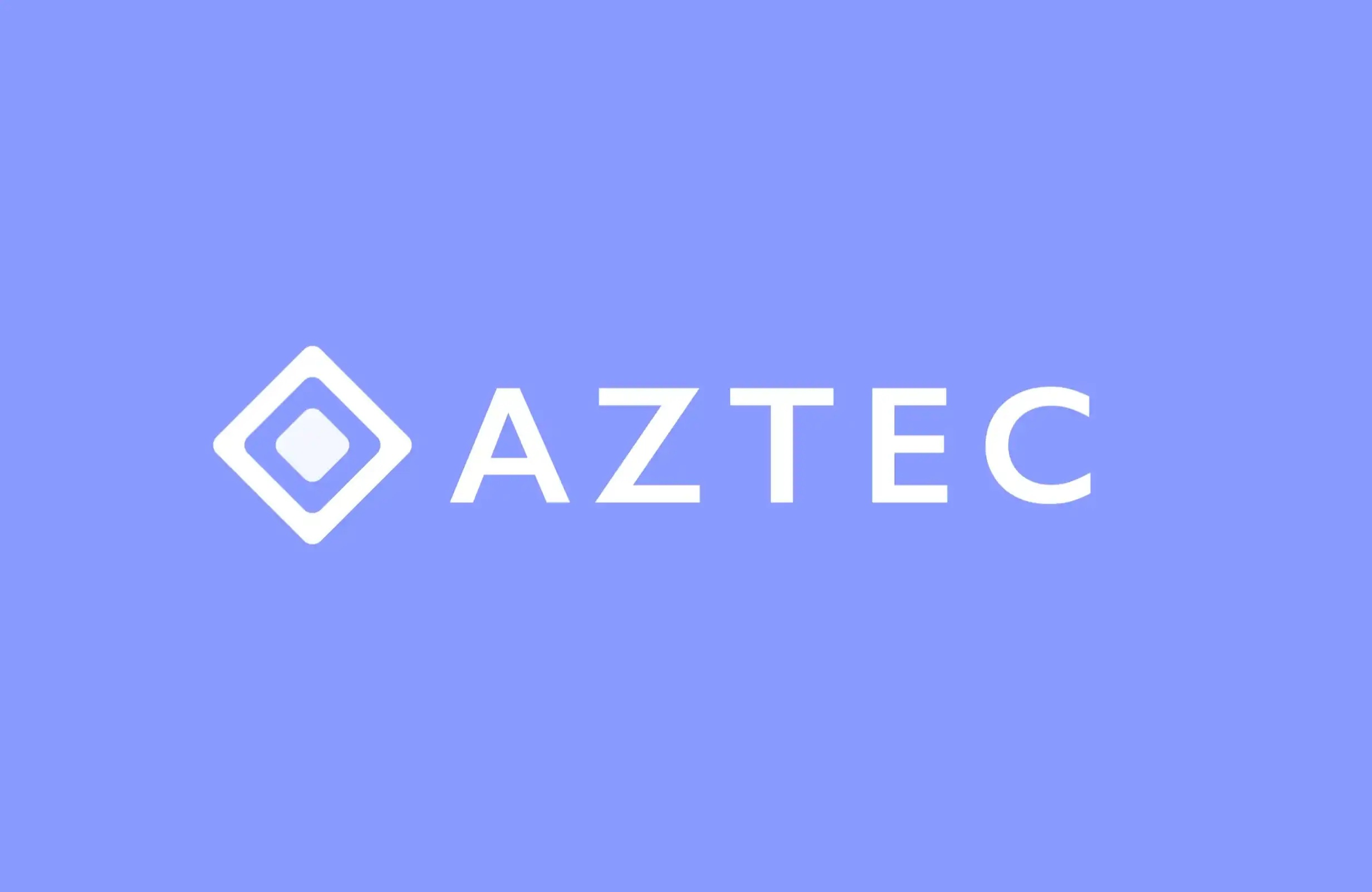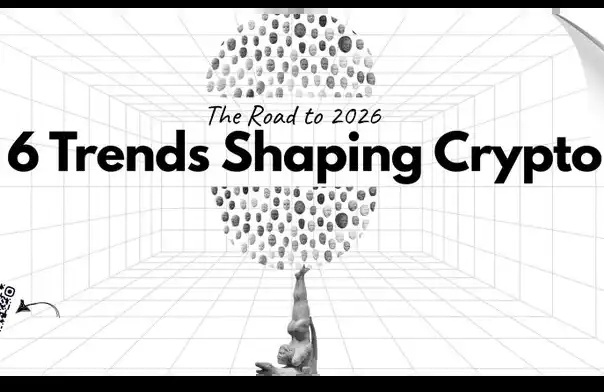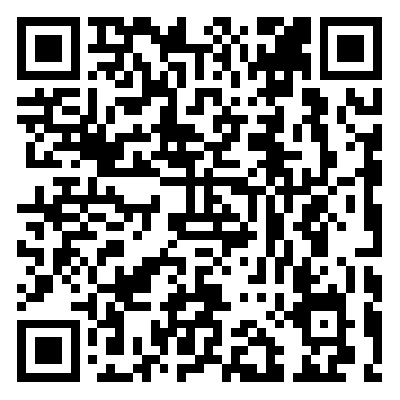The Block annual Report (below) : Web3, NFT trend interpretation
The Block Annual Report (PART 2) : Interpretation of Web3 and NFT Trends & NBSP;
原文来源: The Block
Glacier Web3 Lab
Chapter 5: Decentralized Finance: Overview of 2021, Prospects for 2022 & NBSP;
Decentralized finance: Overview in 2021, Outlook in 2022
Look at decentralized finance, including: lending, decentralized exchanges, derivatives, decentralized stablecoins, leverage, and more.
The profile
- Total value locked in DeFi is over $100 billion. Most of the money has been allocated to lending platforms and decentralized exchanges. However, most DeFi tokens perform worse than Ethereum.
- An eight-fold increase in the amount of stolen funds compared to the previous year was the result of 50 misappropriation incidents totalling us $610 million.
- Regulatory pressure will divide and reshape DeFi. More and more applications will enforce KYC requirements and require trust in product facilitators.
Status of DeFi in 2021
Decentralized Finance (DeFi) is an open, multifaceted financial system driven by smart contracts and blockchain predictions, an alternative to the traditional opaque system run by decades-old infrastructure and processes. It provides users with unpermised and borderless access to a variety of financial instruments without relinquishing control of assets to intermediaries such as brokerage firms or banks.
The liquidity mining boom (LM) triggered by the "DeFi Summer" in 2020 kick-started DeFi's unlimited opportunities and continues to attract liquidity in 2021. The net value of DeFi agreements soared from $16.1 billion to $101.4 billion this year, with the majority of crypto assets allocated to loan agreements and DEXs.
However, DeFi token dominance as an asset class has declined after a strong first quarter. The DeFi dominance index stood at 1.0 percent in January, 3.2 percent in April, and 1.5 percent now.
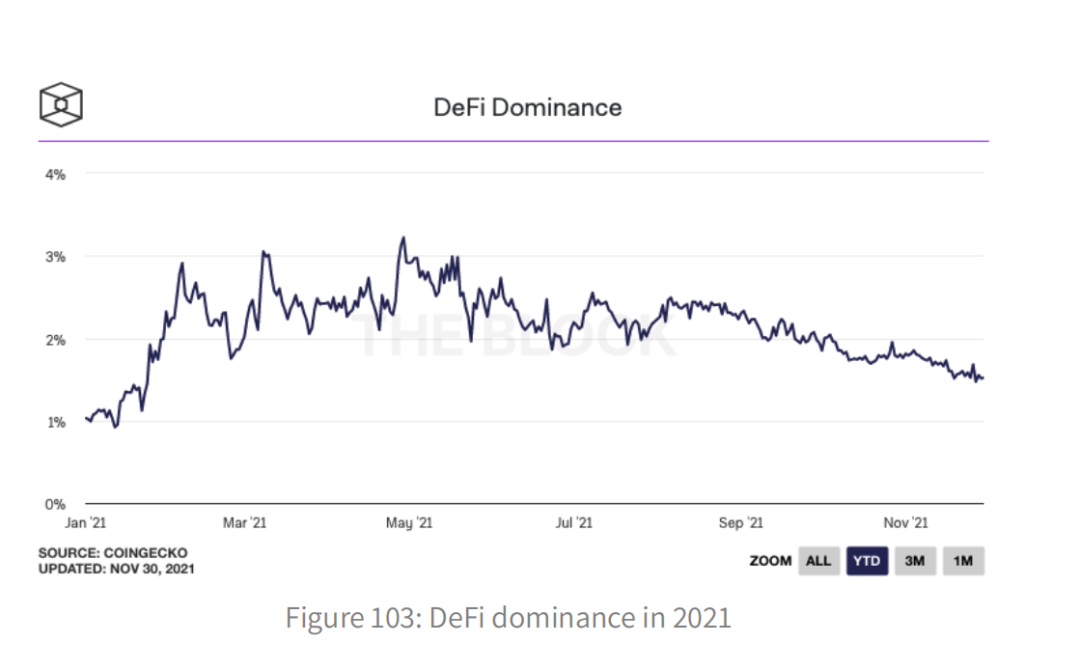

Using DeFi "blue chips" (UNI, AAVE, COMP, SUSHI, SNX, CRV and YFI) as proxies for DeFi token performance so far this year, most blue chips have outperformed BTC but underperformed ETH despite a solid start to the first quarter. CRV is the only company to outperform ETH so far this year after explosive growth in q4, while SNX, YFI and recent COMP are the worst performers. The strength of ETH may be partly due to the growth of DeFi, as DeFi activity is more active on Ethereum. Uniswap was the most used DeFi protocol in May, with over a million active users. On average, 45.7% of Uniswap's monthly active users are new.
Uniswap also received the bulk of DeFi revenue from major loans, exchanges and derivatives agreements, earning $2.2 billion in 30 days. However, most recorded DeFi revenues are supply-side, that is, fees belonging to users of the agreement, such as liquidity providers and lenders. Of the major DeFi protocols, only 8.1% of revenue goes to the protocols and their governance token holders.
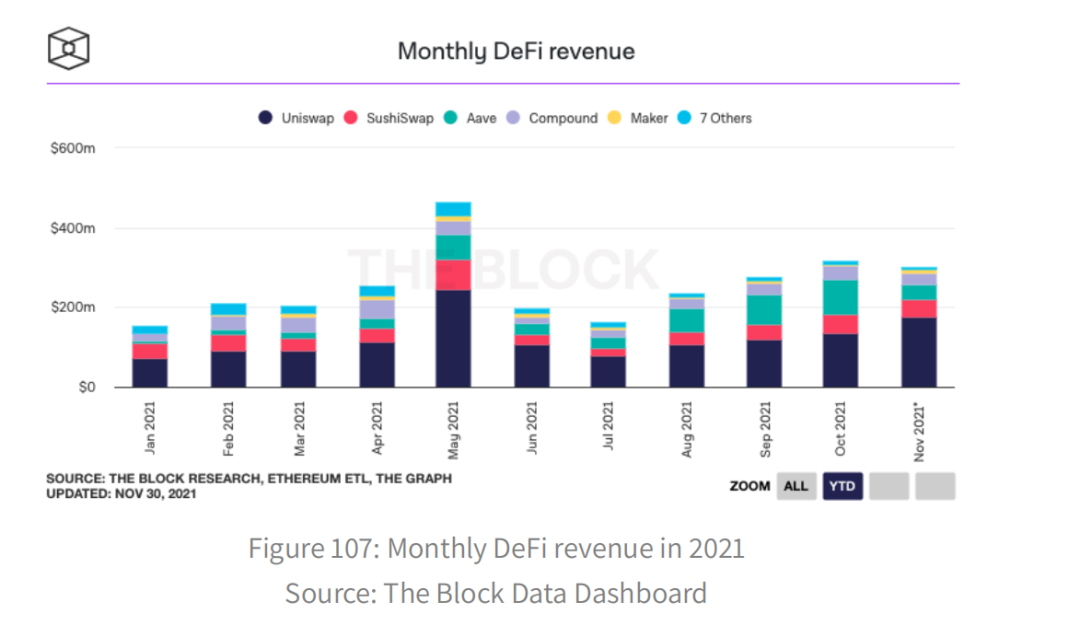

Lending
Lending is one of DeFi's main pillars, as the market has witnessed the unstoppable growth of TVL loan agreements from $7.1 billion to $46.8 billion in 2021, which represents an increase of 559.2%. The top three loan agreements by lock-in value were Maker, Compound and Aave, with TVL at $18.3 billion, $12.8 billion and $10.8 billion, respectively, and total outstanding debt at $9.1 billion, $7.7 billion and $6.5 billion, respectively.


Maker drives DAI, the largest diversified stabocoin, while Compound and Aave are money markets where interest rates are adjusted by algorithms determined by loan pool utilization. Compound's borrowing rates were more volatile and relatively high during the bull market earlier this year, but they stabilized after May. Stabocoins have consistently had higher interest rates than major cryptocurrencies, reinforcing the belief that the market has a long-standing bias.

A common feature of these widely adopted loan agreements is that all loans issued must be over-secured. If the position is deemed risky, the collateral can be forced by the shareholder to cover the outstanding debt, usually when the position falls below a certain minimum collateral ratio. In this way, loans can be made anonymously and untrusted, while reducing the risk that the agreement will collapse if the defaulting borrower defaults. Despite the dominance of long-standing lending agreements, the market is becoming more diversified as new lending platforms are fine-tuned and targeted at different niche audiences. Cream attempted to include long tail assets in its money market, but presented significant risks to the integrity of the agreement, as described in the DeFi Exploits appendix. Kashi of SushiSwap and Fuse of Rari introduced separate loan portfolios to insulate these risks at the expense of capital inefficiency.
On the other hand, Alchemix and Abracadabra use the earnings generated as collateral, which mitigate some of the inefficiency of capital while also introducing composability risks. In addition, TrueFi is the first on-chain unsecured lending platform that maximizes the capital efficiency of credit borrowers. Interestingly, despite many attempts, regular fixed rate loans remain unattractive to high performance DeFi users due to liquidity fragmentation. While LM helped boost liquidity temporarily, it distorted bond prices when organic demand was absent.
Decentralized transactions
In addition to loan agreements, automated market makers (AMMs) can channel passive liquidity from market participants eager to deploy idle assets into yield. Overall, monthly DEX transactions peaked at $162.8bn in May 2021, with the biggest month-on-month increase of 137.3% in January. Volumes, however, have not fully recovered from the slump in May, with dex's spot volume ratio to centralised exchanges remaining below 10 per cent for the year.
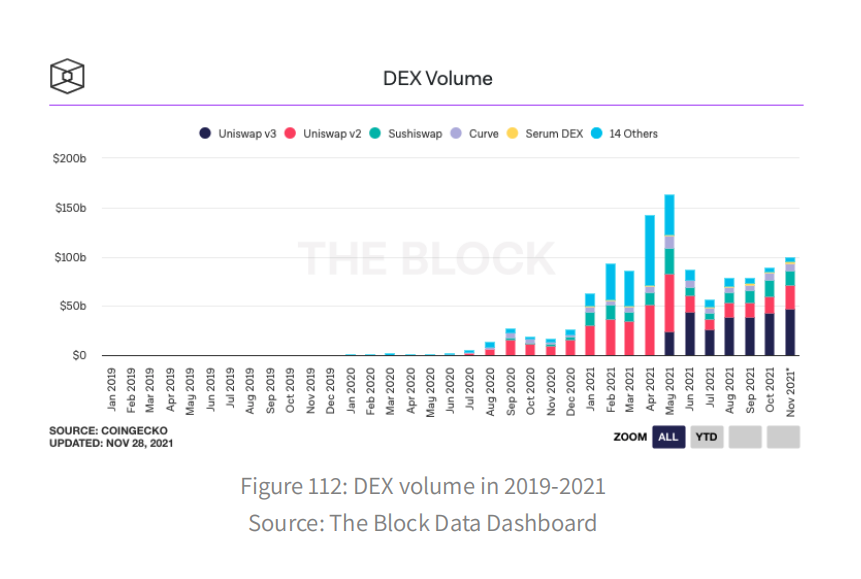
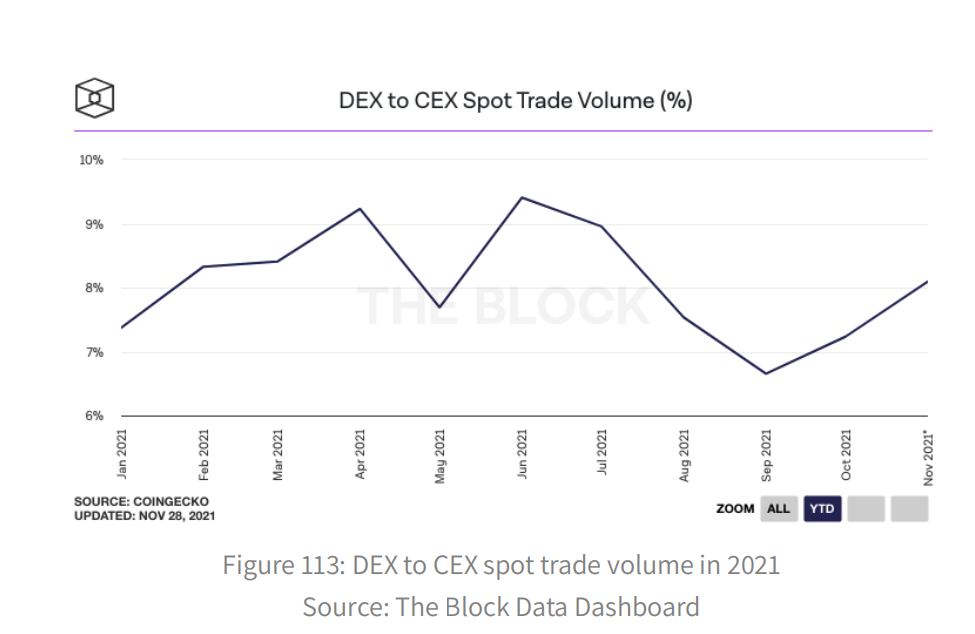
Curve is the largest DEX with a market capitalization of $16.8 billion, accounting for 6.8% of DEX's trading volume. Curve is an AMM optimized for transactions between similar assets, because liquidity is algorithmically concentrated around the peg system. Due to its continued competitive LM and lack of non-permanent losses, it generates low risk and sustainable returns.
Uniswap, on the other hand, continued to lead in terms of numbers, with Uniswap V2 being the largest DEX until it was replaced by Uniswap V3 in June. At its peak, Uniswap V2 saw $59.2 billion in monthly transactions in May, but it was dwarfed by the later versions due to V3's centralized liquidity design, which greatly reduced liquidity slippage. Uniswap V3 was released in May and is under the GNU license to prevent potential imitators, as mentioned in the Market Conditions section. SushiSwap has failed to keep up with the growth of its competitors, with TLV sales of $5 billion and a market share of 15.0%. While most of the orders were placed through AMMs, the largest DEX order by volume was Solana's serum, which accounted for 2.6%.

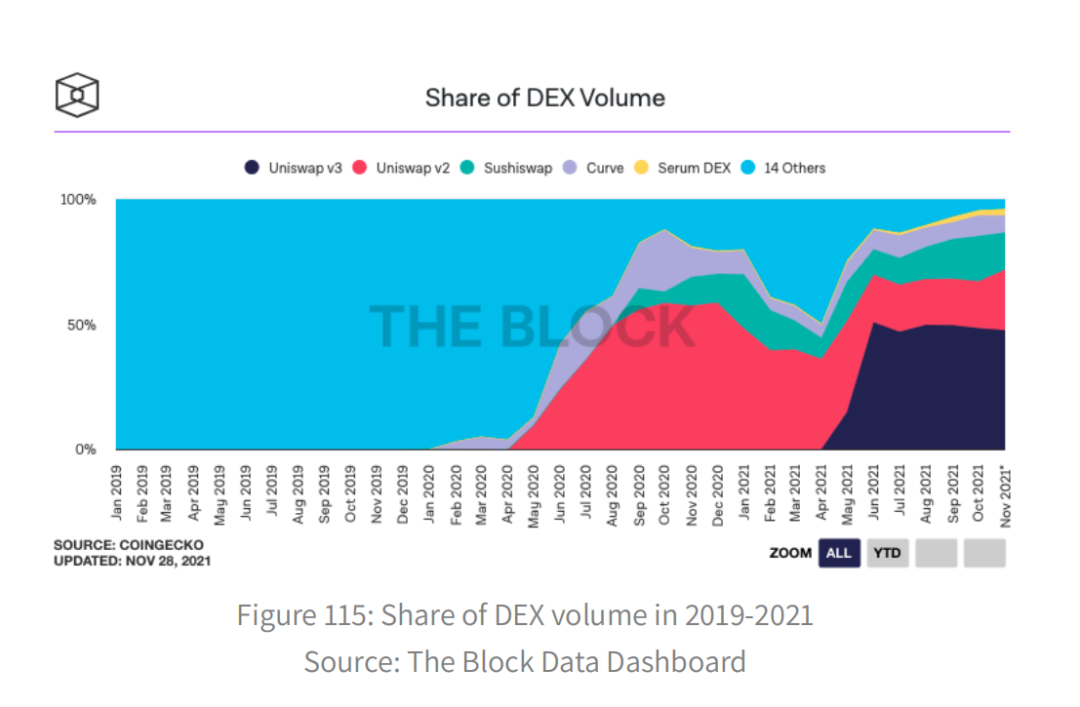
As liquidity becomes fragmented, users may prefer to trade through DEX aggregators, which provide better execution by optimizing switching paths. Surprisingly, on average, only 13.9% of DEX volume comes from aggregator sites. A lot of data comes from DEX local routers or trading bots. 1Inch was the annual leader in DEX aggregation with 64.9% market share, followed by 0X API(matcha) with 16.8%.
Derivatives & have spent
The largest cryptocurrency market by volume comes from permanent futures contracts, which do not mature or settle but trade close to benchmark reference index prices through a financing mechanism. Although exchanges have become more competitive over the past few years, it makes sense that the natural next step would be to extend that success to the derivatives market.
Perpetual Protocol led derivatives trading in the first half of 2021, trading a record $551.1m a week in the week of the May crash. Perpetual operates on xDai side chains and is built on a virtual AMM (vAMM) that parameterizes market depth and slip. With this model, agreements can provide liquidity immediately without the need for counterparties. Another intuitive way is the development of its insurance fund, which charges 50% of the transaction fee. The fund stands ready to back the deal by covering undersecured positions in volatile markets and financing payments when VAMM acts as a counterparty to every deal. Perpetual's insurance Fund currently has $8.2 million in funds.

DYdX has made a comeback since starting its LM program in August with dYdX(the local token for the protocol). DYdX relies on StarkEx, a ZK-rollup layer 2 scaling solution, as described in the Layer 2 section. It utilizes a hybrid infrastructure model, leveraging unmanaged, on-chain settlement, and off-chain low-latency matching engines with order books.

DYdX's liquidity comes primarily from algorithmic market makers operating in the DeFi space (e.g., GSR and Wintermute). Its weekly turnover peaked in September at $9.5 billion, dwarfing Perpetual's achievements. Permanent futures typically operate in isolation from other DeFi protocols, sacrificing composability to improve capital efficiency through leverage.
Synthetic assets, also known as synthetic, are tokenized derivatives that provide countertrading through tokenization and excessive collateral. Synthetix is the oldest and largest Synth publishing agreement to date. SNX shareholders can issue by overmortgaging and trade with other tokens on the Synthetix platform, which offers slide-free execution at Oracle prices. However, as described in the loan section, skew the open interest rate (typically favoring the long) may increase the agreed debt as SNX shareholders collectively and passively underwrite all positions.
Trading volume on Synthetix, which mainly comes from a combination of foreign exchange (52.2%) and cryptocurrencies (47.1%), peaked in July at $1.6 billion. Since then, its trading volumes have shrunk, making it a pitfall compared with the fragmented spot and permanent futures exchanges. Syntix's average daily number of traders fell to 13.8 in November from 167.5 in January, suggesting the company has failed to attract retail interest. Whether the index can regain momentum after its recent turn to optimism remains to be seen.
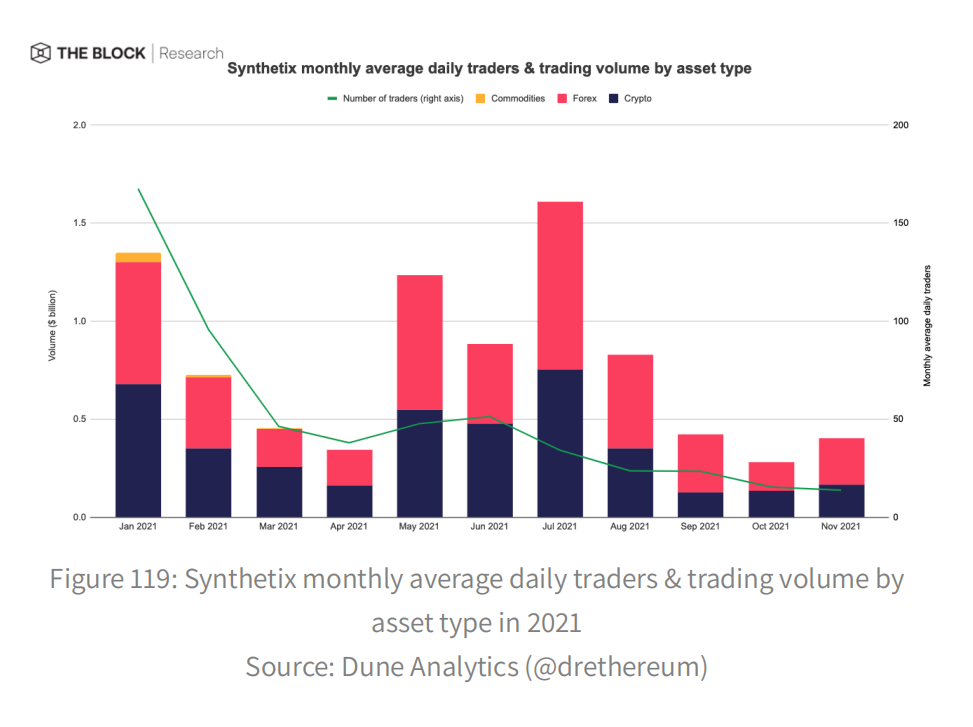
On the other hand, a Terra-based mirror protocol that focuses on synthetic shares mimics Synthetix's over-collateralized approach, but removes the no-slide trading offer so that synthetic shares can only trade on the secondary market. This shifts the burden of skewing open interest to the open market, resulting in mirror issue synths trading at a premium. TVL has held steady on both platforms over the past few months, with Synthetix valued at $1.7 billion and Mirror catching up. Their growth may be hampered by increasing regulatory pressure as Uniswap LABS removed their synthetic token from Uniswap's official front desk and the SEC recently filed an enforcement action against Mirror.

Not all types of derivatives will flourish in 2021. Because of the lack of liquidity and the complexity of the mechanism, the diversified options market has not yet matured into an effective speculation or hedging tool.
Structured product
In recent times, DeFi's growth has been accompanied by an increase in the complexity of portfolio management. It has spawned countless prepackaged structured products that abstract away the complexity of different financial instruments to save investors time and cost. The first iteration of structured products is the return optimizer, which captures and optimizes returns for fund savers. Convex is the biggest yield optimizer in TVL. Launched in May 2021, it specifically rewards shareholders and liquidity providers on TVL's largest DEX Curve, as described in the Decentralized Exchange section. With $16 billion for TVL, which is the first revenue aggregator with an uncertain deal, Convex has surpassed desire, with TVL's $5.9 billion in revenue.

Other types of structured products have also started to develop this year. For example, return grading agreements such as BarnBridge rank returns for investors with different risk appetite, while indices such as DeFi Pulse Index give holders passive exposure to a basket of managed tokens. On the other hand, automated liquidity offering (LP) managers like Charm and Gelato automatically rebalance LP positions on Uniswap V3, while automated trading strategy managers like Ribbon combine various derivatives with higher risk-adjusted returns. These products are still in their infancy, and it remains to be seen whether they will achieve widespread adoption.
The launch of the Beacon Chain in December 2020 initiated ethereum's gradual transition to a proof-of-stake (PoS) consensus mechanism under Ethereum 2.0, as described in the layer by layer section. Users can use Ether as a validator of the network and receive more Ether as a reward. However, being a verifier requires sufficient technical knowledge and upfront funding. Liquid Bet Solutions democratize, totoken and "liquid" bet on Ethereum so that retail participants can get PoS bet exposure and leverage their equity in other DeFi applications such as collateral on lending platforms. Lido became the largest ethereum 2.0 mobile platform in one year, with a market share of 86.6% and TVL of 1.5 million ETH($6.6 billion), equivalent to 1.3% of the current Ethereum supply. TVL in ETH will continue to rise as it cannot be withdrawn ahead of the planned merger of the Ethereum main network with the beacon chain sometime in the first half of 2022.

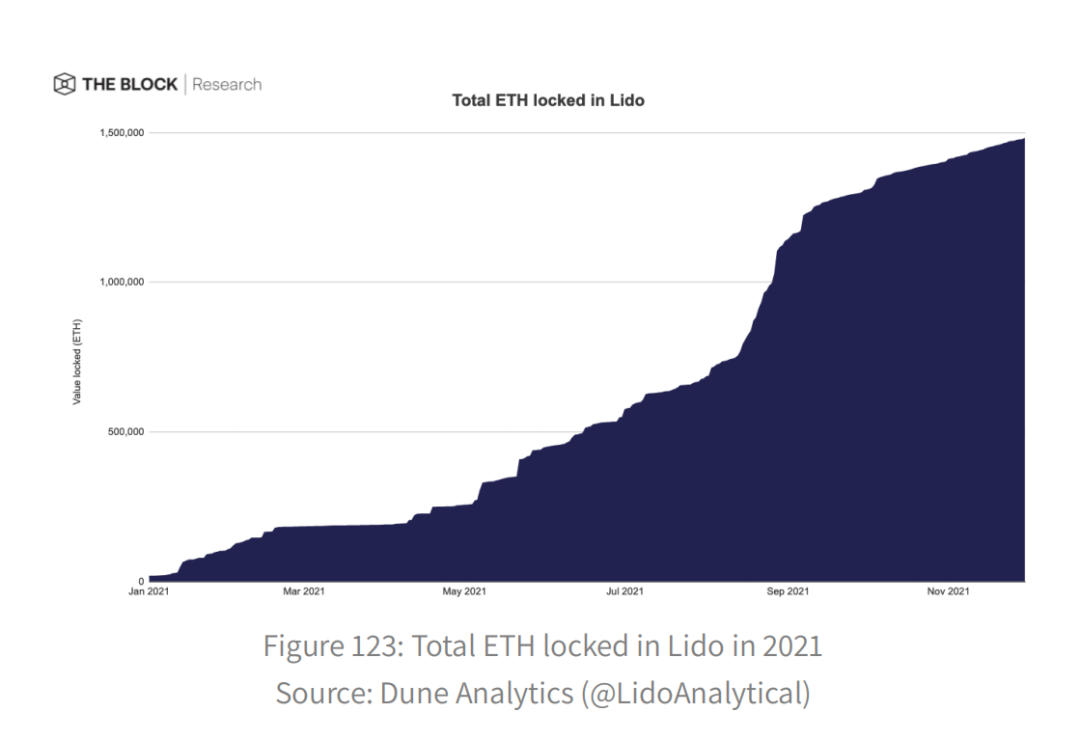
Similar services can also be used on other PoS blockchains. Lido, for example, is streaming live on Terra and Solana with TVL of 68.1 million LUNA($3.5 billion) and 1 million SOL($208.1 million), respectively.
Decentralized stablecoin
Decentralized staboins promote unlicensed payments and leverage. Maker's DAI is the largest decentralized staboin, with its share of the total staboin supply rising from 4.1% to 6.3% in 2021. The balance of DAI increased from 1.2 billion won last year to 9 billion won this year. Thanks to the introduction of the DOLLAR-pegging stabilization module (PSM), DAI's price has stabilized near the dollar peg as it traded at a premium on and off in 2020. PSM allows users to exchange a given collateral directly for DAI at a fixed rate, rather than borrowing money. 14.9% of DAI in circulation are supported by USdcs or USDP derived from PSM.


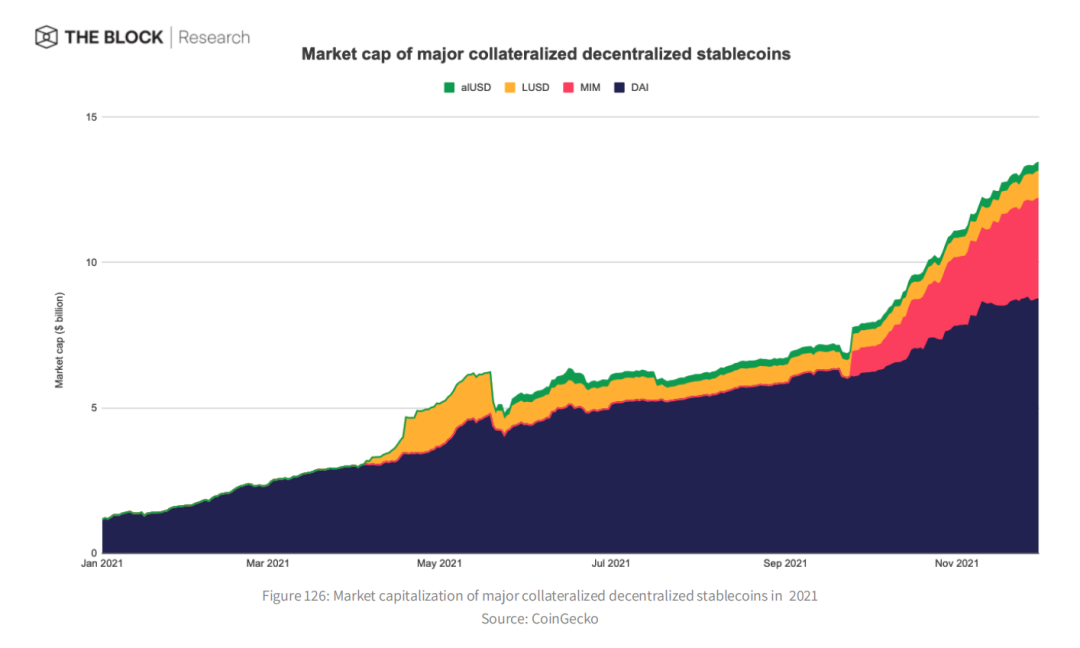
Like other DeFi industries, the prospects for decentralized stablecoins are becoming more diverse. There are currently four decentralized stablecoins with market capitalizations of more than $300 million. Abracadabra's MIM, a stabocoin backed largely by income-generating positions, is by far the second largest diversified collateral stabocoin, with a market cap of $3.5 billion. MIM borrowers earn income on their mortgage assets, which improves capital efficiency.
It has been known for years that the stablecoin trilemma is notoriously difficult to solve. Trilemma refers to the dilemma of stable currency when it has three attributes: decentralization, capital efficiency and price stability. In order to solve the above trilemma, we conducted a large number of experiments on algorithmic stablecoins with mixed success.
In early 2021, we saw the collapse of unsecured algorithm-based stabocoins such as the Empty Set Dollar, due to their lack of risk-free arbitrage opportunities at lower-than-expected pegged exchange rates. However, other algorithmic stablecoins that rely on fractional reserves or endogenous collateral have begun to flourish, with four of them valued at more than $300m.
Terra-based UST is the largest algorithmic staboin with a market cap of $7.6 billion and is backed as an issue-tax share by organic collateral LUNA, of which LUNA is a native asset on Terra's blockchain. $1 worth of issue-tax stock can be burned to produce 1 UST and vice versa. UST has benefited greatly from the explosive growth of the Terra DeFi ecosystem, as UST is heavily used for anchor protocols (a lending platform) and mirror protocols (a synthetic asset issuance platform).
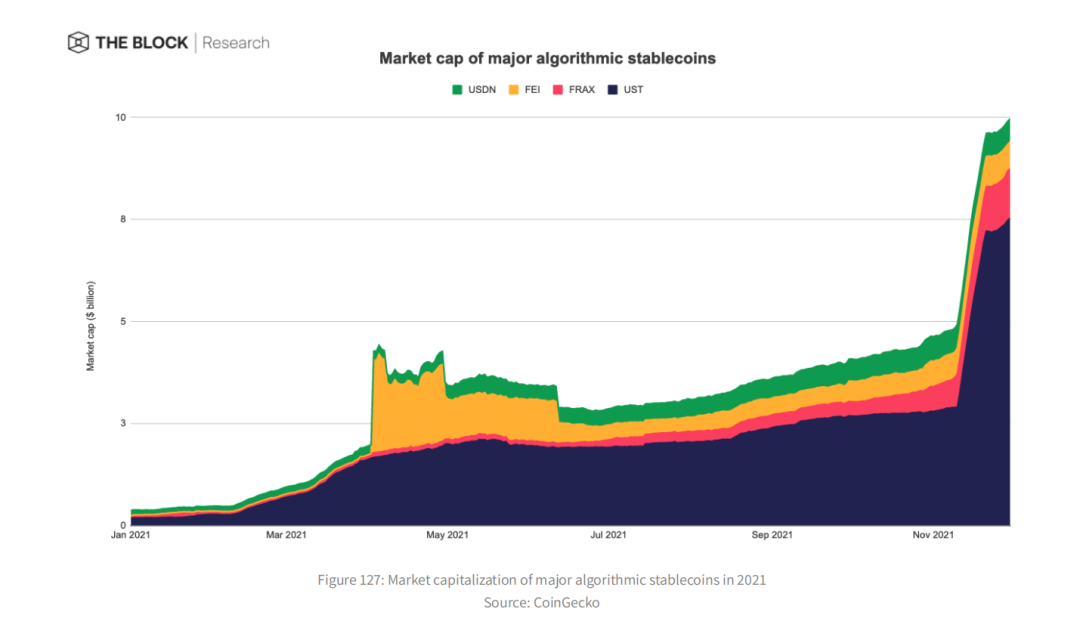
According to the algorithm design, the algorithm stabilization coin may temporarily lose its pin. When the price of LUNA, the issuance tax token, collapsed in May, hkUST's shares traded 3.8 per cent below the dollar peg. A few days later, the dollar peg was restored.
Volatility token
Often referred to as "volatile staboins," algorithmic low-volatility tokens are an emerging asset class that has gained market attention this year. They aim to become decentralized reserve currencies that are less volatile than most crypto assets and less vulnerable to long-term changes in the purchasing power of the dollar caused by unforeseen monetary policy or economic conditions.
These tokens have feedback mechanisms that dampen demand fluctuations by regulating the supply of tokens. Olympus DAO's OHM, launched in March 2021, is the largest low-volatility token with a market cap of $4.1 billion.

OHM tokens are backed by collateral but trade at a premium. This is because artificial demand is created to encourage speculators to buy into Ohm in order to earn more ohm tokens. The DAO gets more collateral by selling ohm at a below-market price, allowing the agreement to issue more Ohm tokens backed by additional collateral. This creates a circular economy driven by speculative demand. Whether these tokens can generate demand beyond pure speculation remains to be seen.
Bitcoin is challenging
In a way, Bitcoin is the first DeFi app that allows holders to store and transfer financial value. Despite the lack of a quasi-Turing-complete virtual machine on the Bitcoin network, BTC is heavily utilized in DeFi applications on other blockchains. That's not surprising given bitcoin's 39.1% dominance of the cryptocurrency market.
The number of bitcoins wrapped in Ethereum has risen steadily, from 140,000 to 3.166 million this year, or 1.7 percent of the entire bitcoin supply. Centralized custodians play a key role in porting bitcoin's value to DeFi, probably due to capital efficiency and user friendliness. Wrapped Bitcoin (WBTC) is the most popular version of Wrapped Bitcoin with 80.0% market share on Ethereum, followed by Huobi BTC (HBTC) with 12.6%, Surpass renBTC in January 2021. The top three WBTC holders are all loan agreements: Maker(20.8%), Compound(13.1%) and Aave(10.1%).
On THE BSC, the circulation supply of currency-linked BTC (BTCB) soared from 53,000 to 105,000 over the same period, suggesting healthy growth in the BSC DeFi ecosystem. The top two holders are Tranchess with 19.8%, a structured product focused on BTC; Venus, at 11.0%, is TVL's largest loan agreement on the balanced scorecard.
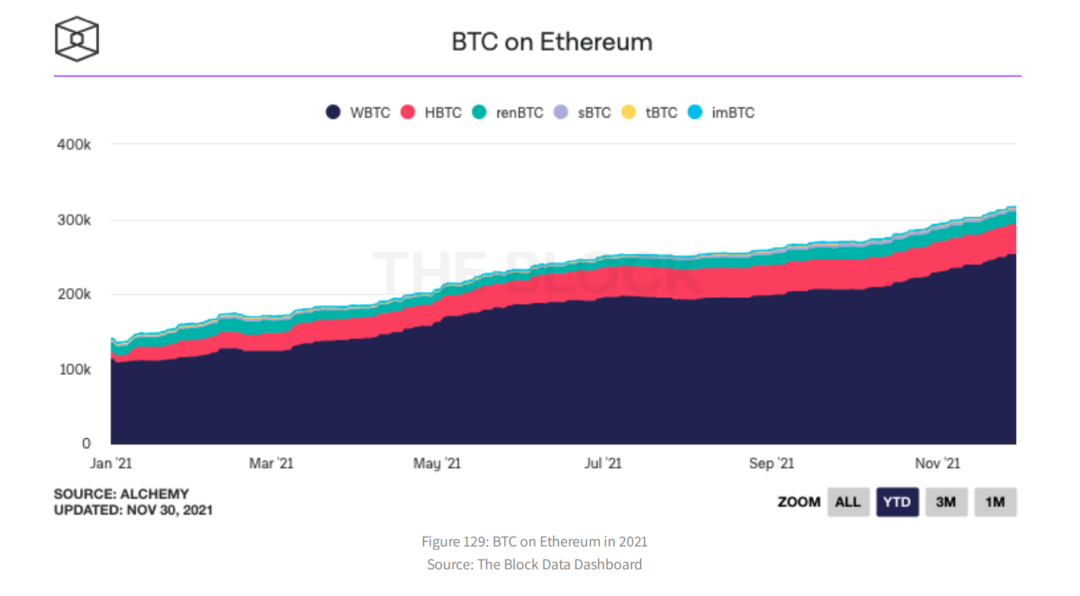
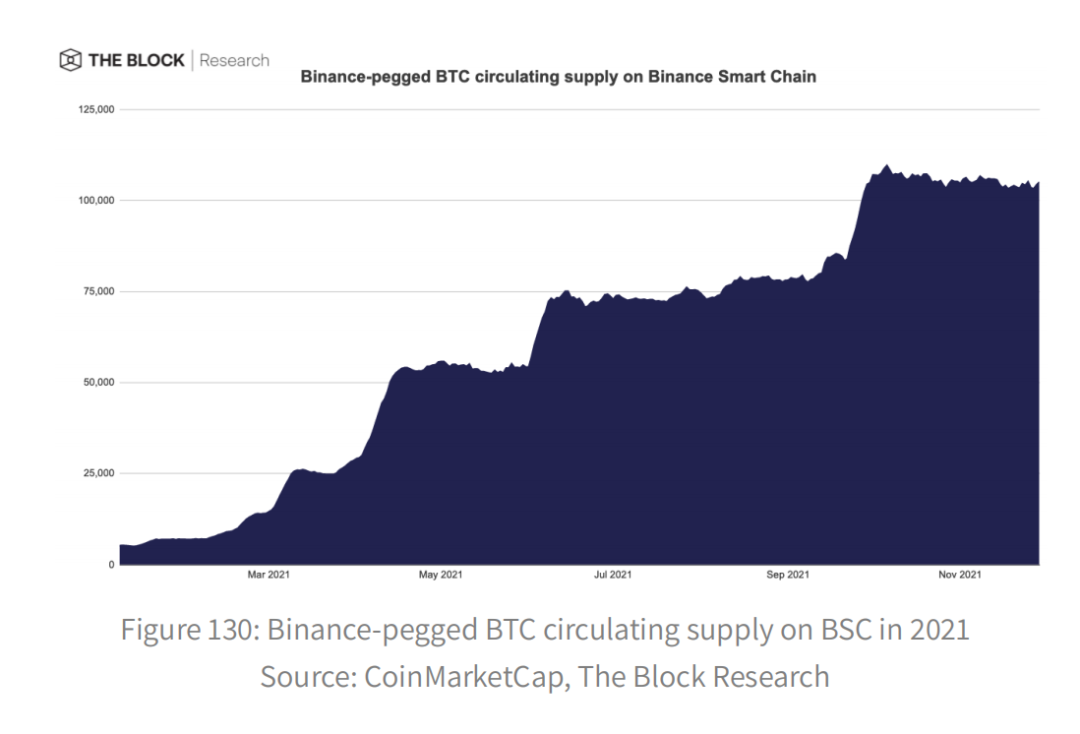
Value of service provider
Servicers' extractable Value (MEV) refers to profits made by exploiting or sometimes abusing the ability of servicers or verifiers to (re) order or review transactions on the blockchain. It is conservatively estimated that cumulative MEV withdrawals over the two-year period exceeded $762.8 million, of which 78.4 per cent was extracted in 2021.
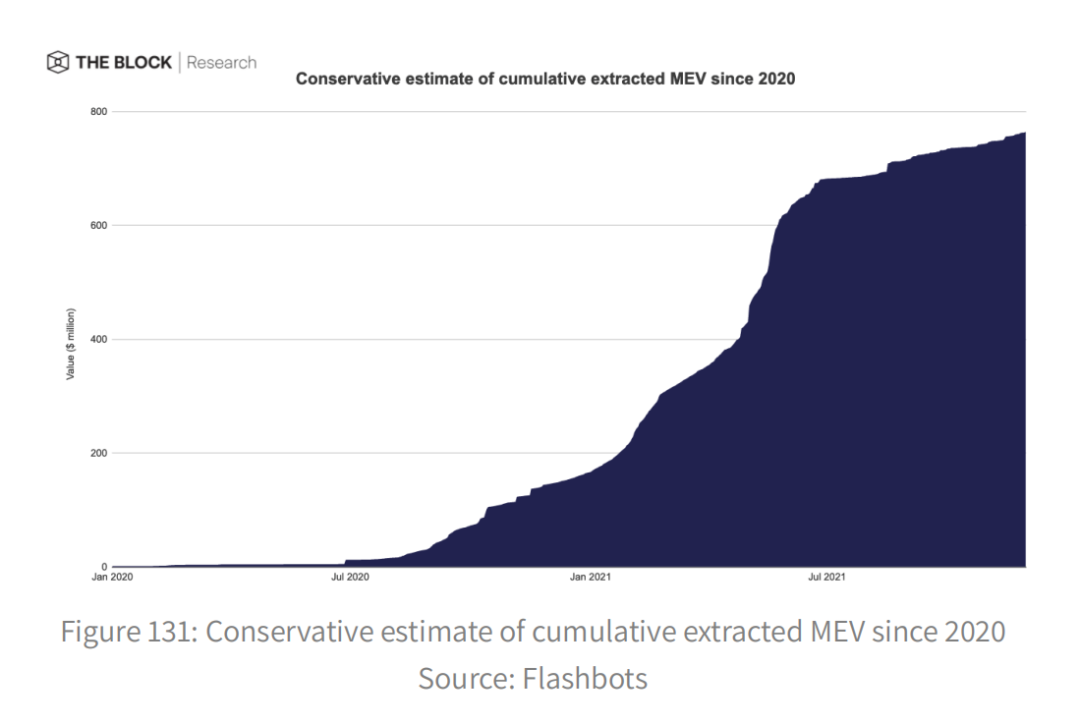
96% of the MEV extracted is related to arbitrage, as arbitrage opportunities abound in the liquidity pools of exchanges. The rest are liquidation related, or both, as such opportunities mainly occur during periods of sharp price falls or short selling squeezes. On average, 88 per cent of profits go to arbitrageurs who initiate trades, while servicers pocket the rest through gas fees and "tips" from the senders.
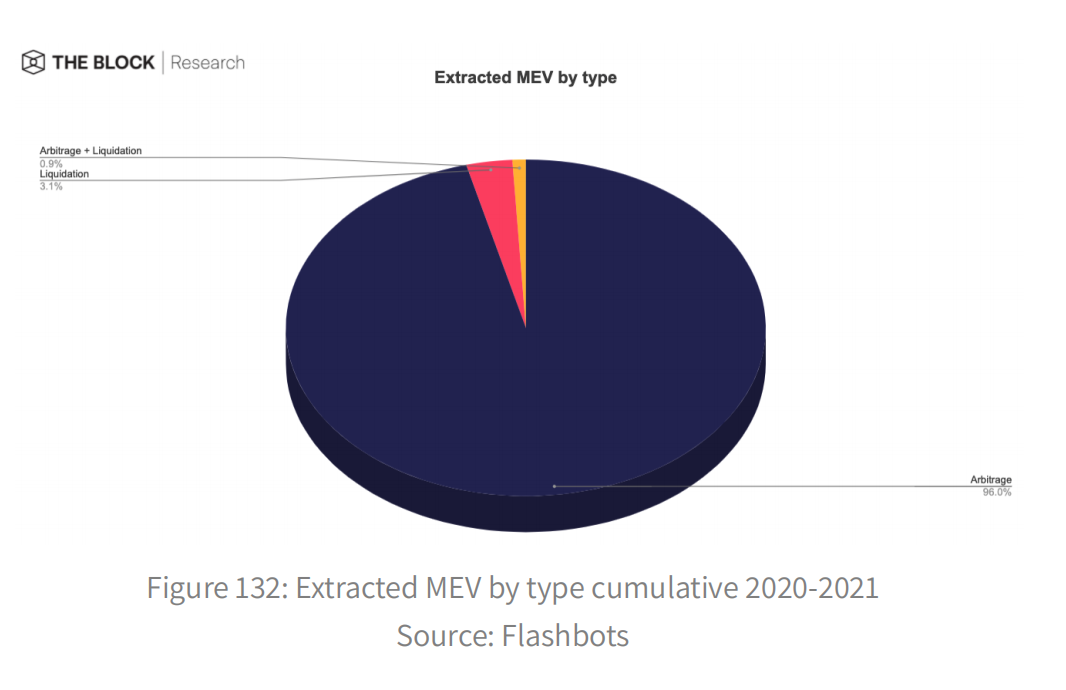
Tools such as Eden Network, Flashbots, and KeperDAO protect transaction senders from predatory MEV bots, which retrieve meVs by running ahead or behind. Transactions submitted through these tools are forwarded to collaborative and economically related servicers, but not broadcast to the public MEM pool.
Smart wallet
There are two completely different types of accounts on Ethereum: externally owned accounts controlled by private keys and contracts specified by code. The contract allows the creation of "smart wallets" that offer greater flexibility. One notable use case is the Multisig wallet, which has been used to secure the original DeFi protocol that has not been fully decentralized. It reduces single points of failure because multiple signatures are required to sign transactions. Gnosis Safe, launched in 2017, has become the de facto standard for Multisig wallets. Usage grew exponentially, with 378,000 Gnosis safes created and 323,900 transactions from those safes.

Smart wallets can also bring user-friendly features to wallet management. Argent and Dharma, for example, allow "guardians" of a user's choice to restore or limit access to their smart wallets. The cumulative number of silver and French wallets grew slowly, from 384,000 and 104,000 respectively, to 594,000 and 164,000 respectively in 2021. However, ETH balances in these wallets have declined by 20.6 percent since January.
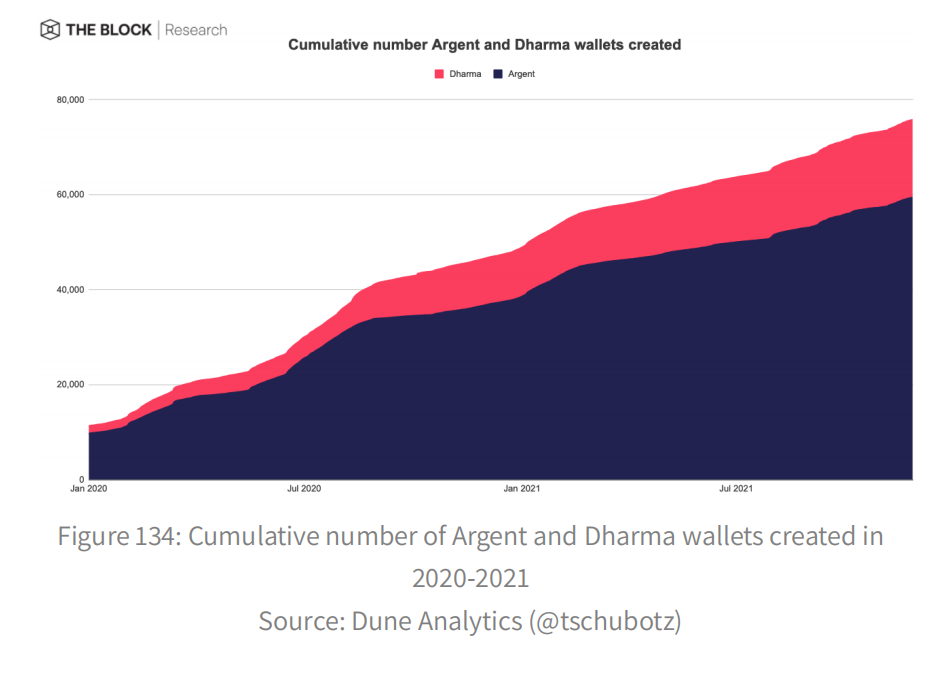

For advanced individuals, smart wallets like Instadapp and DeFi Saver provide a one-stop shop for managing DeFi positions on major protocols through custom automation, such as loan refinancing. Instadapp's TVL skyrocketed to $12.1 billion this year, driven in part by LM.
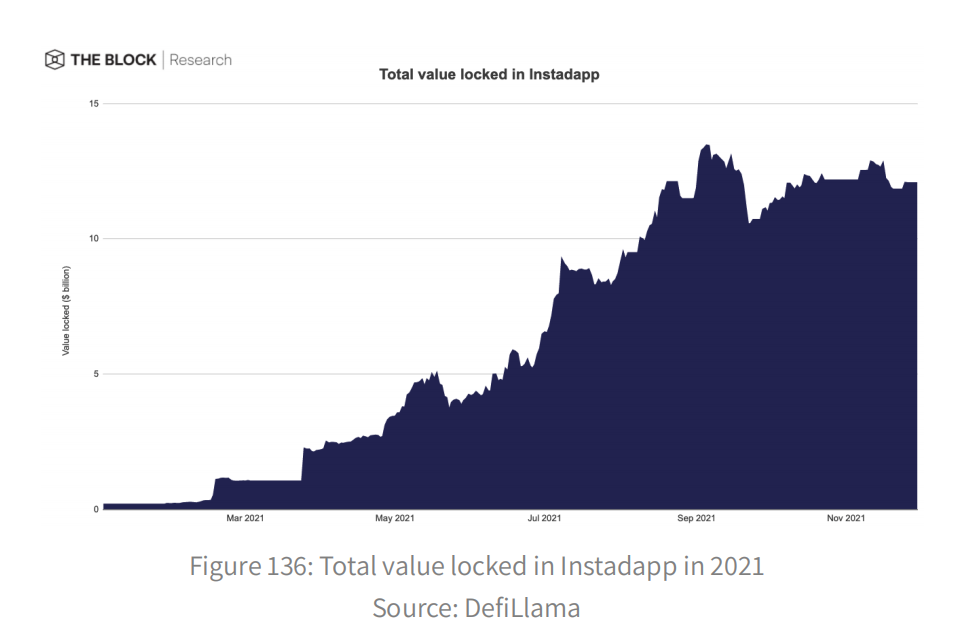
Privacy Tornado Cash remains the Privacy mixer on Ethereum. Its TVL grew from $55.1 million to $695.9 million in 2021, processing an average of $87.4 million in deposits and $86.4 million in withdrawals per week this year.

35.3 per cent of ETH transactions through Tornado Cash this year were 1ETH, while transactions of 0.1 ETH are becoming increasingly unpopular in high gas environments.

While most DeFi industries are booming in 2021, DeFi insurance is likely to be one of the few categories to decline. Active coverage by Nexus Mutual, a leading insurance solution, peaked at $2.3 billion in February and has since declined by 70.0% to $688.2 million.
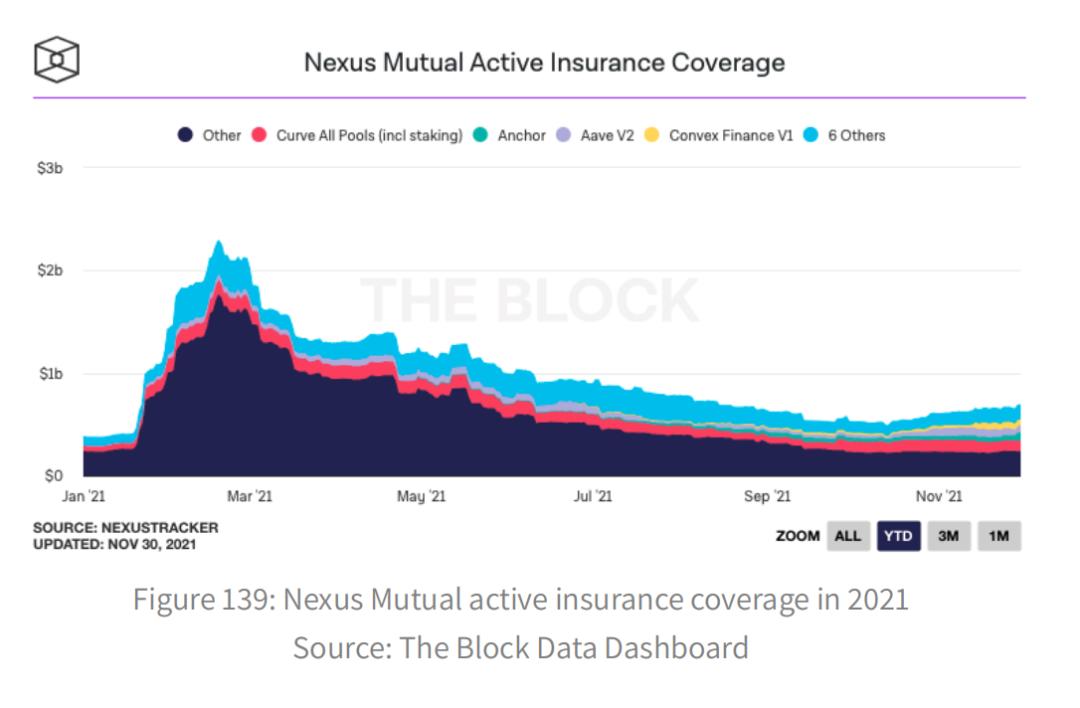
Token service
Initial DEX issuance (IDO) refers to tokens issued through DEXs, which is one of the most popular token issuance methods. However, Naive IDOs, by seeding liquidity pools on DEXs, attracted the leading bots and grabbed a significant portion of the tokens, driving up market prices significantly. They then sell it for a profit. The liquidity channelling pool (LBP) pioneered by Balancer has emerged as a more favourable way to issue tokens this year.
The initial listing price will start with a high starting price to discourage leading competition. Prices will be adjusted algorithmically over time based on immediate purchase demand. It is similar to a Dutch auction, but more responsive to a surge in demand. On the other hand, initial Binding Curve Offering (IBCO), popularized by Hegic Protocol, has become the preferred token offering method for most Solana projects. Investors can deposit and withdraw funds during the sale, after which they can redeem the tokens on a pro rata basis. The more money raised, the higher the valuation of the implied token. Unlike LBP, IBCO offers the same settlement price for all participants of any size.
Some projects avoid IDOs and prefer to distribute tokens to protocol users, possibly due to regulatory concerns about token sales. Some speculators use this model to try to interact with protocols that have not yet issued tokens using multiple wallets, hoping for handsome returns in the future. This is known as "farming by air", and there is debate about the ethics of the practice.
Overview of the biggest DeFi vulnerabilities of 2021
In 2020, the popularity of the DeFi protocol led to an increase in the user base and project TVL. In turn, big TVL attracted the attention of not only administrators, but also attackers, who stole more than $77 million through bugs in 2020. Most of the attacks happen in the fall because of summer DeFi. In this event, many forks are started with minimal changes, which is enough to cause a bug. It seems developers must learn their lesson and take responsibility for their users' money. However, history repeated itself due to a lack of sufficient number of security experts, less competition on other EVM compatible chains, and an inability to quickly upgrade fragile smart contracts.
During the current year, the number of stolen funds increased eightfold, reaching $610 million as a result of 50 uses. The first known DeFi vulnerability involving bZx (02/15/2020) used a temporary loan. There is still debate about whether this primitive creature is harmful to the ecosystem. In any case, about 60%($355 million) of the money was stolen through flash loans.

Another important point is that attackers can return some of the stolen money to the project. This usually happens if the attacker agrees to the bug bounty or if their identity is known. Overall, 53 percent ($704 million) of the stolen funds in 2021 were returned to projects, mostly due to poly network development.

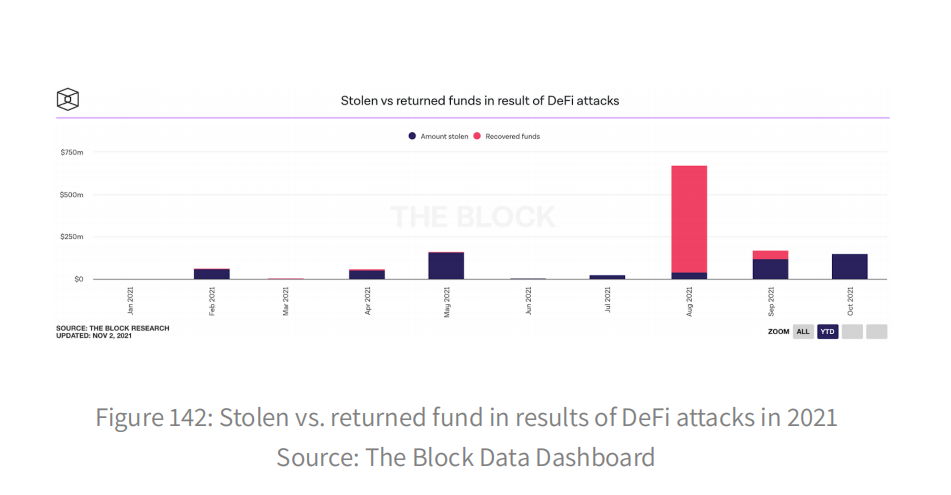
The latest insights confirm that we live in a multi-linked world. While most of the bugs are still on Ethereum, there have also been bugs on BSC, Polygon, and Avalanche since April. About a third of the stolen money, or $200m, belonged to the balanced Scorecard programme, which suffered the biggest loss in May.
You can find a timeline of all major hacks that took place in 2021 in the appendix in the DeFi section.
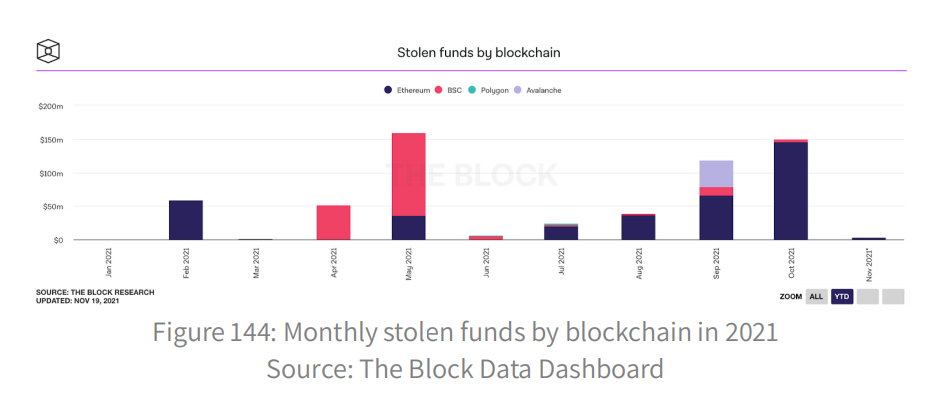

DeFi's competitive prospects in 2022
Prediction markets were one of the first concepts of decentralized applications implemented on blockchain, such as Augur. Despite its early start, it has failed to generate meaningful volumes compared to other categories of DeFi protocols. Polymarket on Polygon is the leading forecast market for 2021, with hot markets showcasing major global events (like the US presidential election and COVID-19) and cryptocurrency trends (like Bitcoin prices, Ethereum upgrades). Surprisingly, sporting events do not attract as gamblers prefer traditional regional bookmakers rather than for better liquidity.

As DeFi becomes friendlier, decentralized predictive markets have the advantage of reaching more users globally, thus providing more competitive rates and deeper liquidity. Retail investors are likely to prioritize user experience over decentralization, while companies that can provide frictionless on/off ramps are likely to get a head start in grabbing market share. Multiple markets currently rely on centralized event prediction for settlement purposes. Going forward, as prediction markets gain traction over time, the market resolution process should make use of decentralized event predictions that are economically sound and resistant to corruption. Whether this can be achieved quickly is questionable, but what is certain is that full decentralization is not currently a priority for predictive market platforms.
Non-dollar stablers;
Most stablecoins are pegged to the U.S. dollar, as stablecoins are primarily used to trade cryptocurrencies in dollar pairs. While there are plenty of stablesoins linked to various fiat currencies, the demand and liquidity do not exist for most of them. Nonetheless, the euro stablecoin is likely to be adopted in the coming years. First, the euro is the second largest stablecoin bloc. There are already two staboins pegged to the euro in the DeFi space. SEUR is Synthetix's synthetic euro with a market cap of $118.7 million, while STATIS Euro (EURS) is the largest euro-linked stabocoin issued by STATIS with a market cap of $102.2 million. Their demand is largely driven by Curve's incentivised EURs pool, which has a TVL of $109.8 million.
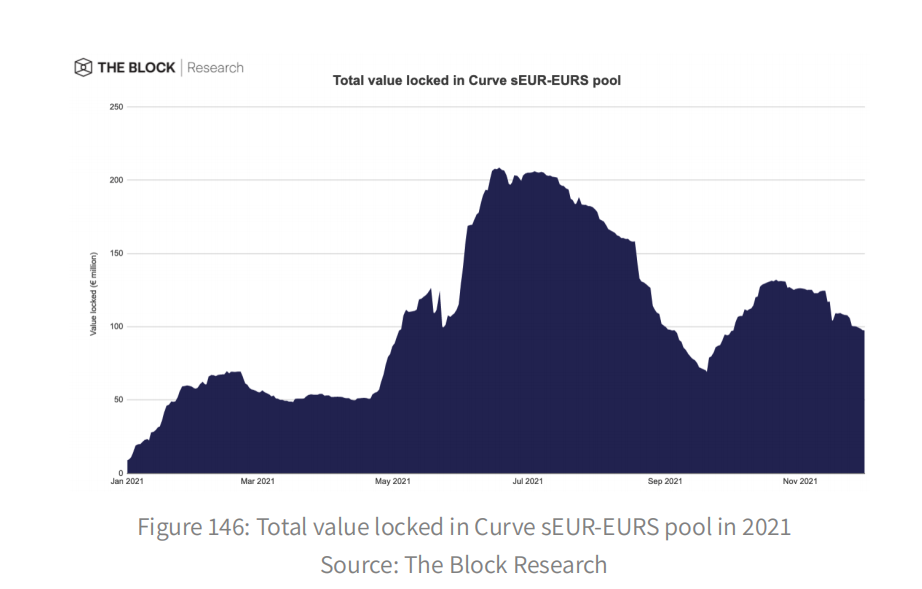
Second, the EU's positive steps and relatively more welcoming attitude towards resolving legal issues surrounding staboins and other cryptocurrency assets could lead to greater adoption of DeFi in Europe. The crypto Asset Market is a proposed regulation that will create a federation-level licensing framework to provide regulatory transparency to a variety of crypto service providers, including stablecoin issuers. The Euro stabler will play an important role in facilitating such adoption.
Tokenization of real assets
While cryptocurrency as an asset class has matured into a $2 trillion market, it remains relatively isolated and isolated from other economies. As the token economy grows, everything of value, whether financial or cultural, will be tokenized in some way. Closing the gap between real World assets (RWAs) and DeFi can bring great "old wealth" to the new digital economy and enhance the emerging DeFi ecosystem. Tokenized RWAs benefits from the existing blockchain and DeFi infrastructure.
For example, Centrifuge is a blockchain that facilitates tokenization of RWA like NFT and provides financing for different types of tokenized assets through DeFi. Tinlake is the investment gateway for centrifuge's RWA capital pool, holding over $44.4 million in TVL funds across 10 RWA capital pools. Tinlake's real estate bridge loan pool financer, New Silver, funded its first loan with an initial $5 million line of credit, becoming the first company to use RWAs to back Maker's DAI stablesoin. Soon, todate RWA loans could be used as collateral for Aave.
Innovation in derivatives
DeFi has fostered countless experiments over the years, and that's unlikely to stop anytime soon. Just as centralized crypto exchanges revived permanent futures, enabling futures markets for then-illiquid crypto assets, DeFi is poised to revolutionize the derivatives market with creative and novel designs.
Permanent futures never expire and do not need to be delivered. In addition to significantly simplifying users, it also provides liquidity providers with greater capital efficiency by consolidating liquidity from multiple maturities into a single market. The same framework applies to the crypto options market, which suffers from fragmented liquidity and high rollover costs. The money paid for the "perpetual option" would be a function of the difference between the marked price and its intrinsic value (i.e., the volatility premium).
The novelty and complexity of these instruments may lead to mispricing at first, but it will become more effective as the market matures. In addition to perpetuating options, other potential derivatives include power perpetuations designed to maintain the convexity of options while consolidating futures liquidity, and floor perpetuations that track the lowest price of a particular set of non-fungible assets. Despite the promise, most of them will have only limited success without incentives.
Guided flow
Fluidity produces volume. Most DeFi projects fail to harness network effects and create self-sustaining momentum because they are unable to attract short-term and sustain long-term liquidity. LM's ubiquity may have demonstrated its short-term effectiveness, but questions remain about its efficiency and sustainability. In terms of efficiency, the existing LM incentivizes liquidity over the entire price range, from zero to infinity. This is a misalignment of resources, since most liquidity is never used.
Only a few projects, such as Instadapp, focus on incentivizing liquidity on a narrow scale on Uniswap V3, probably due to unfamiliarity with the implementation of a centralized LM. We will see the emergence of variations of LMS that reward loyal liquidity providers for providing meaningful liquidity. Rewards can be weighted by a basket of liquidity-related parameters, including concentration, proximity to market prices, loyalty, and so on. LM provides diminishing marginal utility in terms of sustainability.
Mercenary liquidity providers sell off their returns, creating huge selling pressure and devaluing return tokens so that yields fall over time, causing liquidity providers to reduce their liquidity. Ultimately, LM is the overhead of an agreement to one day reach escape velocity. This amounts to renting liquidity from mercenary capital, and the objectives of the agreements and liquidity providers are inconsistent.
Recently, Olympus DAO proposed the idea of protocol-owned liquidity (POL), which goes without saying. Since decentralized agreements cannot eliminate liquidity, at least not without thorough process of governance approval, the liquidity possessed by the agreements themselves is essentially permanent. Instead of renting liquidity from mercenary capital, the agreement buys them directly by issuing bonds, by which the agreement trades tokens in exchange for liquidity of said tokens. Whether POL and bond sales can revolutionise the art of bootstrap liquidity remains to be seen. Nor would it be shocking to see other innovative approaches to this multi-billion dollar problem that affects all DeFi protocols.
Governance Reform & NBSP;
The interests of governance token holders and protocol users are inconsistent. Only 7% of users belong to these two groups, and the time span of users from these two groups is very different. Token holders generally prefer to maximize the extraction of short-term value, even at the expense of the long-term sustainability of the agreement. In contrast, protocol users prefer the longevity and neutrality of the protocol.
Maker is a classic example of this governance dilemma. MKR holders benefit from higher DAI loan rates, while borrowers clearly prefer the opposite. If users can't rely on voters to make decisions that are in their best interest, users will turn away. The curve's voting lock solves this dilemma.
Curve's native token CRV does not directly provide voting rights. However, CRV holders can lock tokens to receive veCRV, which grants the holder voting rights. The longer tokens are locked, the more VECRVs (and votes) they will receive. That way, curve voters have a vested interest in DEX's durability. Moreover, liquidity providers on Curve can earn higher returns if they acquire and lock in CRV, thereby motivating users to actively participate in governance. Different implementations of vote locking are likely to be widely used in DeFi governance to realign interests among stakeholders.
Bifurcation challenges
Institutions are eager to put money into DeFi but face numerous obstacles due to regulatory uncertainty, ranging from KYC/AML practices to securities law related concerns. Some protocols foster the concept of "permissive DeFi," which, forgive the oxymoron, can satisfy existing compliance requirements. Some argue that such developments defeat the purpose of DeFi. Still, distrust is not the answer to everything. Some applications require trust from certain parties, such as borrowers and facilitators of unsecured loans, RWA toxified trustees, etc.
Open finance should not just decentralise all aspects of finance, but bring choice and transparency to users. These projects will be able to obtain war funding from institutional giants who have never had access to DeFi. Some existing decentralized agreements, such as Aave Arc and Compound Treasury, are also developing a separate division to cater to institutional clients. Still, most agreements are unpermissioned, and more and more developers of such agreements will remain anonymous. They will speed up the process of full decentralisation and avoid scrutiny at all costs.
The threat of restricted access will also accelerate the development and adoption of a privacy-enhanced DeFi ecosystem driven by zero-knowledge technologies. Today, many "decentralized applications" rely on centralized components, such as centrally managed user interfaces, proprietary routing optimization algorithms, and so on. As regulatory pressure mounts, they will be forced to pick sides. Some companies will comply with and enforce KYC processes, or restrict users' use in certain jurisdictions; Others will remain anonymous, giving up control of the front end and smart contracts. Regardless, a DeFi fork seems inevitable.
Chapter 6: Web3:2021 overview & NBSP;
Look at Web3, the technology that pushed the web to a turning point, and explore the latest data to see where we're headed.
The profile
- As Web3 matures, it is important to have frameworks to understand its technology organization and interactions, and how they generate new user experiences;
- To this end, we develop an integration model for Web3, which describes Web3 as a "horizontal" evolution of Web2 technology;
- Here, we explain the new framework and delve into its aspects, from the technical details of simplifying access to blockchain data to the numbers and numbers behind recent Web3 economic activity.
In November, Solana, Lightspeed Ventures, and FTX announced a $100 million fund for Web3 game development to support game studios and technologies that integrate Solana into desktop and mobile games.
Bumble revealed that they're exploring how to incorporate blockchain and encryption into the reboot of their dating platform BFF through the "Web3 lens."
Crypto venture capital firm Paradigm announced a massive $2.5 billion fund to develop Web3 applications, noting that the journey of Web3 and encryption is just beginning and that Web3 applications currently only reach a fraction of the audience that Web2 does.
Global interest in the term "Web3" also hit a record high on Google in November, up about 150 per cent since the beginning of October. The Y-axis below is a measure of search interest relative to the highest point between January 1 and November 30.
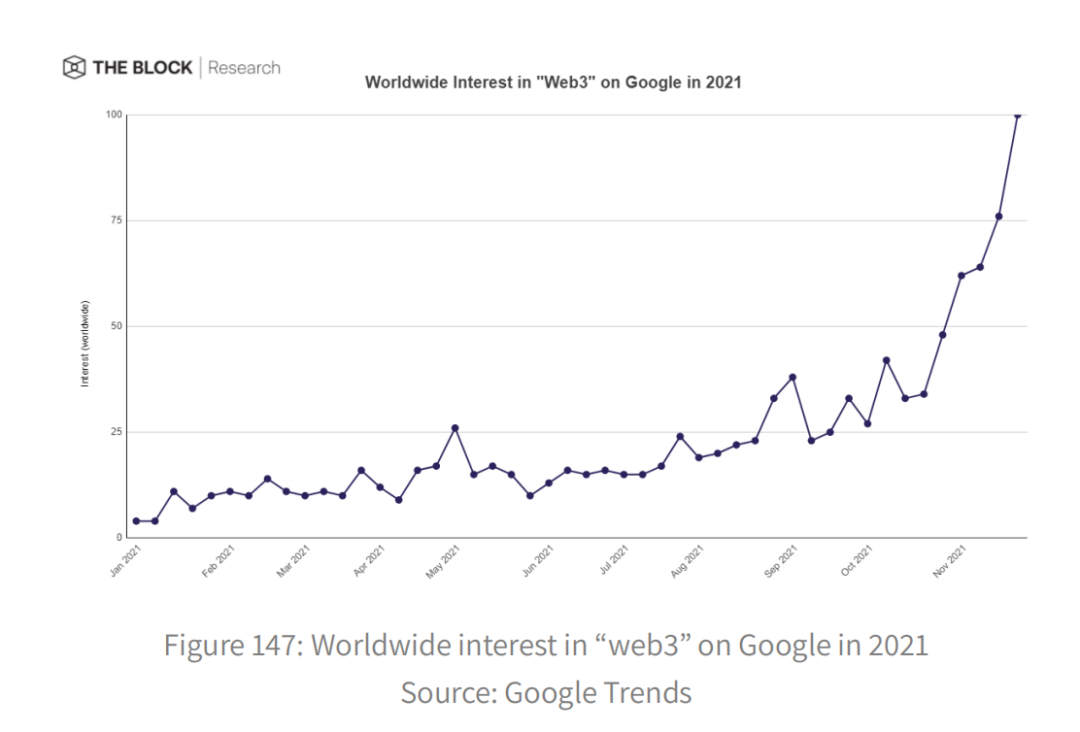
Despite all the hype, there is still a lot of confusion about what Web3 is.
We have developed an integration model for Web3 that focuses on the technological evolution that is taking place at the Web architecture level. Next, we'll discuss this model, its context in the history of the Web, and how developments on the back and front ends of the Web have led to major changes in the way people use and experience the Web.
A simple framework for understanding Web3 technology
In a sense, "Web3" (e.g. "Web2") is just a buzzword used to encompass a new set of phenomena on the web. These terms can be misleading because the web is constantly evolving and does not "upgrade" from one version to another at a time. However, periods of rapid development do occur during certain evolutionary inflection points.
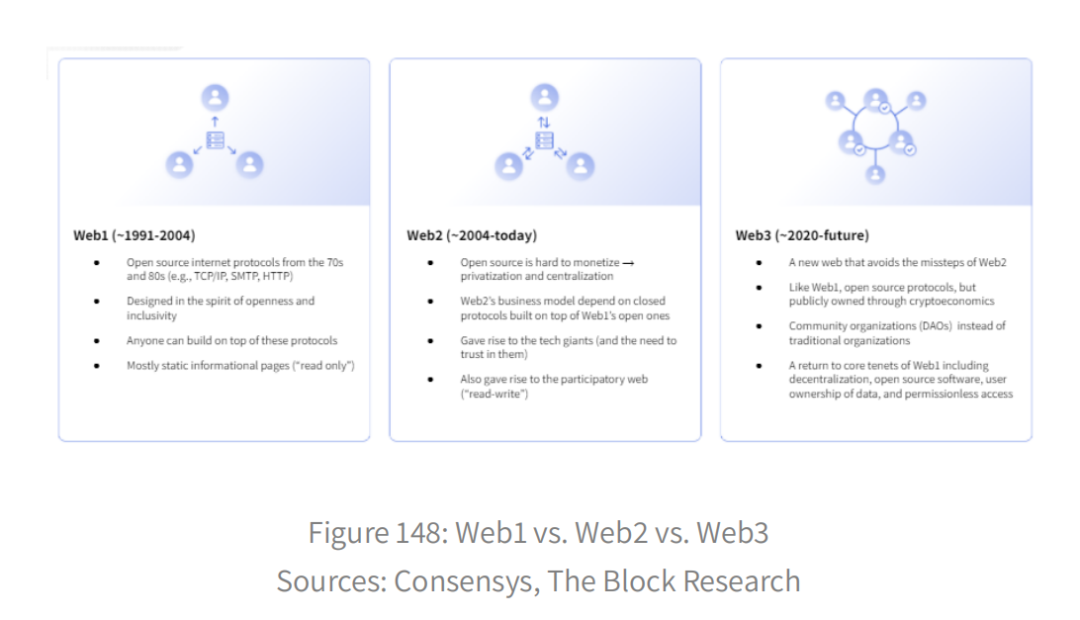
In the case of Web2, growth is primarily about commercialization and possible social experiences on the web -- some of the key differences include turning users into first-class entities with prominent profile pages that can connect with many users and publish multiple forms of content, And internal messaging systems and common application programming interfaces (apis). In Web3, significant developments are taking place on both the back end and the front end, from the way data is stored and served to the novel user experience of integrating wallet applications and Web3 gateways. At the social level, there is a move towards more publicly constructed and owned networks managed by community-owned and operated organizations supported by blockchain technology. That being said, Web3 is still in its early days, and any claims of "revolutionizing" or replacing Web2 technologies are premature.
This may be due to a lack of clarity about how clients and servers communicate in Web3. Next, we try to address this issue by focusing on specific developments occurring at the client-server level of the Web infrastructure.
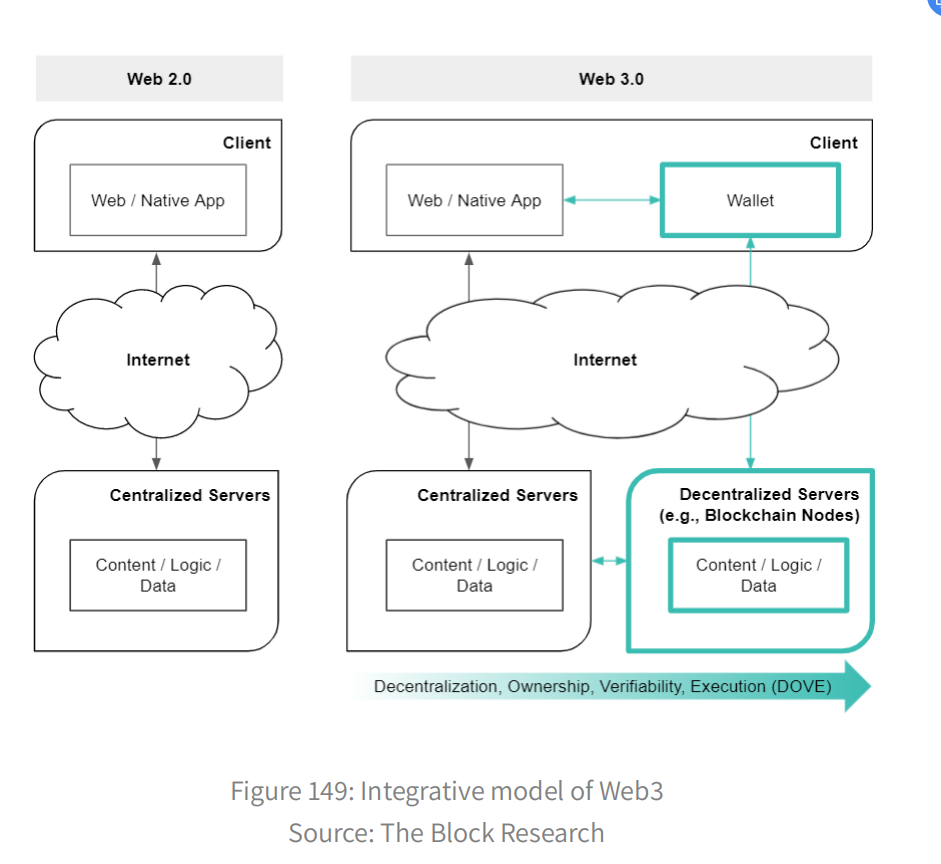
On the left, we show a simplified description of the technical infrastructure for Web2, the dominant form of networking since circa 2004. Essentially, Web2, also known as "participatory" and "social networking," consists of client and server computers that communicate over a network. Internet Protocol stack. In contrast to "Web1," which refers to the first phase of the Web's evolution from roughly 1991 to 2004, Web2 involved more two-way communication between clients and servers.
The increase in client-to-server communication capacity enables users to compose and update data in a secure, reliable, trusted, and scalable way that has never been possible before -- and therefore, sometimes. Web1 is referred to as the "read-only Web," while Web2 is referred to as the "read-write Web." These capabilities pave the way for new developments, such as user profiles, internal messaging systems and social networking platforms.
Looking at the server side, we noticed. Web content (for example, HTML/CSS, JavaScript, images, video), application logic (for example, for serving dynamic content over HTTP), and data (for example, data stored in database management systems such as MySQL) are stored on privatized and centralized servers in Web2. Web1, by contrast, is relatively decentralized, with static pages of information hosted primarily by web servers operated by various Internet service providers (ISPs) and free web hosting services. One reason for server-side privatization and centralization is the economic opportunity presented by the social evolution of Web2. This is the first time we've been able to create a thriving digital marketplace. As with any market, knowing your customers is critical to effective marketing.
As a result, we've seen the birth and explosion of digital marketing, the commercialization and commoditization of personal data, and the competition among tech companies for data. To this day, the tech giants that survived the dotcom bust are in constant competition to find ways to capture and control that value. Power is concentrated by a few companies that control these precious resources -- for example, the cloud infrastructure market is dominated by a few tech giants (e.g., Amazon, Microsoft, Google). Essentially, the line between client and server becomes blurred in Web2, because the client also "provides" valuable data and resources to the server. In the process, customers lose ownership of these data and resources because they typically do not own or operate server computers.
Web3 technology, decentralization, and "propaganda"
Now it is clear that the Internet has lost its original one of the core principles: "don't need permission from the central agency can publish any content on the Internet, there is no central control node, so there is no single point of failure... and there is no" stop switch "! It also means not affected by indiscriminate censorship and surveillance." The decentralized vision of networks has been replaced by the reality of digital territories controlled by monopolistic technology companies. But after a long period of rigidity, the tech industry's top-down structure is showing signs of weakening.
Critics have voiced concerns about censorship, surveillance, misinformation and user exploitation, and antitrust regulators are cracking down on big tech companies to root out monopolistic practices. At the same time, we have had an influx of talented developers working to build a new version of the web that respects its original utopian vision of upholding the principles of freedom, inclusion, community and civility. As Tim Berners-Lee, the web's inventor, put it - "a web that works for everyone".
But as the past two decades have proven, building scalable and secure DApps is hard. It seems that combining decentralization with the user experience we are used to and need in Web2 is computationally infeasible on a Web2 infrastructure. Server-side centralization may also be the only viable computing solution to meet the needs of Web application users. Fortunately, decentralized solutions may exist in blockchain and related technologies. Bitcoin, for example, is a blockchain-based application that currently operates in a distributed fashion on a large scale, with approximately 14K full nodes and counts accessible. Technical security increases with the size of the network and the value of individual users, and the appeal of non-users increases with network effects. As a result, talented developers around the world are looking in this direction for a way to build a new network that avoids Web2 missteps.
To understand the major technical differences of this new network, let's first review the major server-side developments. In the figure below, we zoom to the bottom of the Web3 diagram to provide simplified instructions on how to store and communicate various data structures in Web3. In Web2, we store Web content, application logic, and data in a centralized Web server, application server, and database server, respectively. User actions performed at the front end of the application initiate a series of information requests and responses at the back end. For example, an HTTP request sent from a client browser can trigger the Web server to communicate with the application server through API calls and the application server to communicate with the database server through SQL queries. The HTTP response is then sent from the Web server back to the client that contains the relevant information.

In Web3, data structures currently stored in centralized Web, application, and database servers can be stored separately in decentralized IPFS, Ethereum, and Arweave nodes. A centralized application server can request data stored in these decentralized servers (that is, blockchain nodes) via remote procedure calls (RPCS) and then provide relevant information to a centralized Web server. In addition, blockchain nodes can send relevant information via RPC to a Web3 front-end application, such as a wallet (for example, MetaMask) or a gateway (for example, IPFS gateway). This is just an example; other Settings are possible. For example, content such as HTML can be stored on the Arweave node, and data sets can be stored on the IPFS node. Application logic, create-read-update-delete (CRUD) commands, and financial execution can be implemented on Solana nodes or other decentralized computing platforms.
Decentralized design
One of the key choices developers need to make when implementing Web3 technology is the degree of decentralization they want to give their designs. The common misconception is that "Web3" and "Web2" websites and applications exist, but the reality is less clear, and applications now have access to a Web3 back end, opening up even greater potential for decentralization. Initially, the goal of many developers was to maximize the spread of their applications, but this has proven to be idealistic due to the slow and expensive nature of today's blockchains. In the short term, "Web3 applications" are likely to still leverage the Web2 infrastructure to some extent (perhaps we should label them Web 2.1, 2.2,... 3.0 applications to ensure accuracy). For example, Uniswap.org and other popular DeFi applications host their front ends on centralized servers, and their domains are purchased from centralized DNS hosts.
The wallet
Going back to the overall picture of Web3, we can see that Web3 also comes with front-end development enabled by the new back-end development. Perhaps the most prominent development to date is the user wallet, which allows us to securely view blockchain information, such as account balances and transaction histories. Importantly, we can "own" wallets -- so-called "self-hosted," "unhosted," or "user-controlled" wallets -- in software or hardware.
Ideally, the owner, and only the owner, has full ownership and control of the private key that accesses the wallet. In other words, the wallet software does not copy the private key information, preventing a third party from controlling the wallet in any way. Note that what we "own" is actually a private key for accessing a typical public address linked to common user data, such as account balances replicated and stored in a decentralized manner across many servers. Another option is "managed" or "hot" wallets -- these are typically controlled by centralised exchanges such as Coinbase and Binance, which manage user money through pooled wallets also controlled by the same entities.
As a result, they offer users less ownership and security, but also less responsibility and more convenience. A software wallet like MetaMask can also act as a gateway for Dapps. To use dApps, users need to understand the state of the blockchain and be able to interact with it. MetaMask, for example, allows users to access Ethereum blockchain data through Ethereum nodes provided by Infura by default, opening access to the expanding universe of Ethereum DApps.
However, users can set MetaMask to access the Ethereum blockchain through another node provider or even through their own nodes. Alternatively, they can access the Ethereum DApp through a different wallet or through RPC's custom application.
Again, these capabilities point to a continuum of user control that is not possible on a Web2 infrastructure. If Web2 is about the shift to user prominence and social, then Web3 seems to be about the shift to user control and empowerment.
Decentralization, Ownership, Verifiability, Enforcement (DOVE)
At the bottom of the figure, it illustrates how the shift to a Web3 infrastructure contributes to four key changes in the user experience -- from decentralization to ownership to verifiability to execution (DOVE). We use the word "change" instead of "benefit" because every change must have costs and benefits.
Decentralization is an effect of the way servers are connected in the Web3 and Web2 infrastructures. A simple way to think about it is that data structures in Web2 are managed primarily by large servers controlled by a few entities, whereas in Web3 they are managed by smaller servers controlled by a large number of entities. Also, in Web2, access to the server side is limited to those who own server farms, whereas in Web3, access to the server side is inclusive, so that one person can actually own both client and server computers. The former system provides users with a data network that is easier to deploy, develop, and maintain but more prone to single points of failure, security risks, and privacy intrusions. The latter systems promise open and trustless infrastructure, censorship resistance, and no single point of failure, but tend to have lower throughput, require more computing resources, and are more complex to implement and coordinate.
Ownership is the effect of the native state of the Web3 blockchain layer -- the way we keep state or history publicly by running nodes, which is guaranteed by consensus rules, rather than relying on private information brokers (tech giants) and gatekeepers who act as creators of both parties to our own user state and history. In other words, due to the lack of native state in Web2, the user has no history -- no data, identity, security, or transactions -- and no requests for these from trusted intermediaries. In this way, the state properties of the Web3 infrastructure lay the foundation for a trustless infrastructure in which mediations can be removed without losing functionality. However, ownership comes with responsibility. In the absence of a mediation, we gain user control at the expense of the services of the mediation.
Verifiability is the effect that blockchain data is publicly available through a fault-tolerant group consensus mechanism. In the case of a truly decentralized blockchain, anyone could download and verify the entire history of verified blockchain data. With no intermediary entity between users and their country, blockchain "belongs" to everyone equally and fairly. In this way, decentralization and ownership are verifiable like never before. They can directly verify selective and copyrighted information about what we own and what others own, making it possible for parties who do not know each other to reach value agreements over the Internet for the first time. The downside here is to implement verifiability;
Fault-tolerant consensus mechanisms require an extreme form of cross-node data replication and processing that can quickly become computation-intensive. Execution is a smart contract executed exactly as it was written, with no mediations or closed protocols and opaque code. In other words, a smart contract is automatically executed, and the terms of the agreement between the parties it interacts with are written into open source lines. In addition, there are many open source smart contract libraries available that provide reusable building blocks for Web3 projects. It is in this way that Web3 returns to the open and inclusive spirit of Web1. Modular and open design allows for a greater degree of networking and community collaboration that is not possible in a Web2 framework. The challenge in this case is how network collaboration can develop and deploy applications at a pace that competes with centralized Web2 operations.
discuss
All in all, Web3 opens up the potential to openly own much larger portions of the web (again). It does this by building a base of linked data on the back end that we call a blockchain -- data that is decentralized, censor-resistant, verifiable and publicly available. These technological developments and the trust-free systems they produce have created what some see as a new layer of Internet value settlement -- a way to exchange value securely across the globe without borders.
The future will tell us just how valuable the new web quality brought about by the Web3 infrastructure will be. Now infrastructure has begun and time-tested Web2 combination of infrastructure, we can expect the developers would be more horizontally their platform and Web3 technology integration, to meet the users to decentralization, ownership, verifiability and implement demand demand will naturally consider the benefits and costs involved. One of the key challenges in moving to the Web based on distributed data is how users and developers can efficiently and economically bring blockchain data into applications. If Web3 is to be decentralized, a robust, secure, and economical node network infrastructure is essential. Next, we'll focus on the Web3 infrastructure that can leverage blockchain data in an efficient, secure, and economical way.
Centralized and decentralized Web3 infrastructures
Currently, there are centralized and decentralized operations that can simplify blockchain data access. For example, blockchain infrastructure providers like Infura and Alchemy provide portals to blockchain data, but they are developed, owned, and operated by centralized entities. On the other hand, projects like The Graph and Pocket Network already offer decentralized solutions for accessing blockchain data.
Decentralized access to decentralized data.
It seems that the future of Web3 will depend on a base layer of distributed, secure and immutable ledger data across multiple blockchains. Then, Web3 faces three key challenges:
1) How to efficiently transfer data from blockchain to application;
2) How to easily access data across multiple blockchains;
3) How to do A and B in A decentralized way.
In a decentralized Web architecture, a reliable node infrastructure is critical for decentralized computing. A decentralized computing network can be divided into three general components:
1. Apps. These are any software that submits API requests (for example, queries, relays) that will be routed to any public or encrypted database node.
2. The node. They are decentralized servers that provide functions such as storing database indexes, sending session information to applications, servicing API requests submitted by applications, and storing network state such as account balances and work reports.
3. Network layer. The ecosystem that sustains the operation of decentralized protocols, including governance, protocol rules, the participants involved, and the economic games in which they play.
As shown in the figure below, relay or index nodes sit between applications and blockchain nodes (or other decentralized network of servers) from which they retrieve data. After processing the data from the blockchain nodes, they send the information to a centralized or decentralized application server.
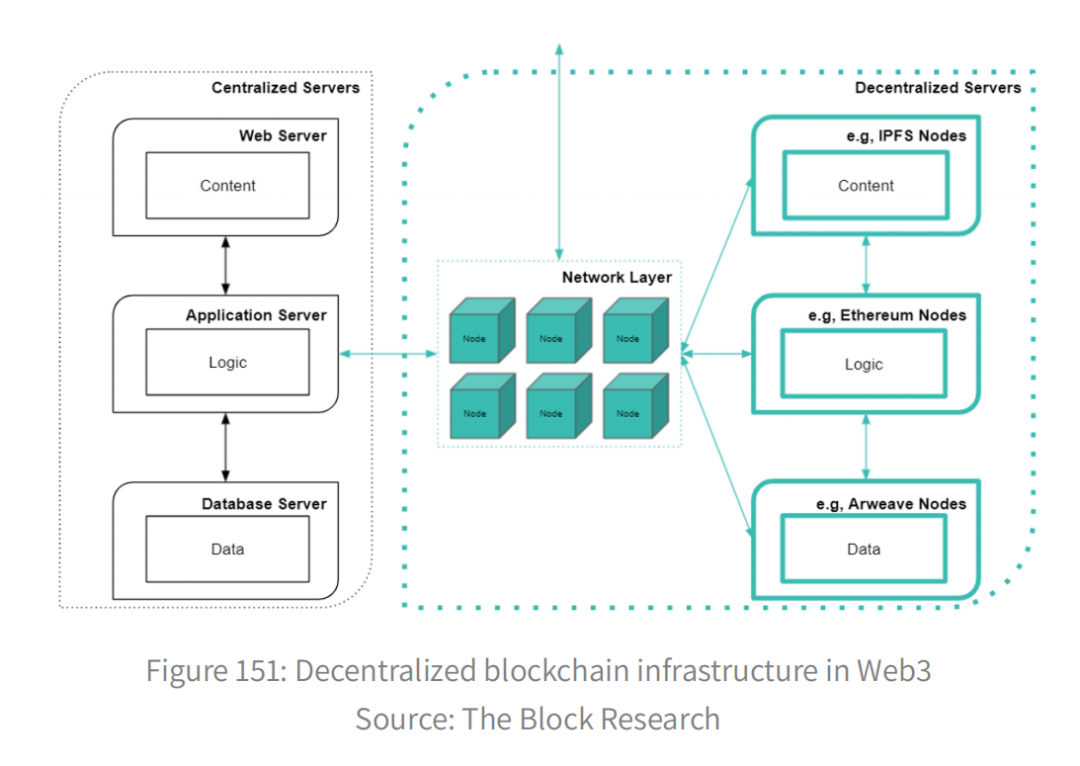
Next, we'll explain how a decentralized computing infrastructure works with two sample cases: diagrams and project networks.
The Graph: Spread indexes and queries across a package
Web3 applications can query data from the blockchain by filtering or searching. Since blockchains store data and handle state transitions, the process can be slow and computationally intensive, but they don't index the data. Indexes make finding related data faster and less computationally demanding. Before The Graph, Dapp developers built their own database indexes for their users and clients. However, this approach reduces the credibility of the DApp by keeping the index data in a centralized database (rather than scattered nodes). Setting up your own index server is also redundant for many teams. In The Graph, The subgraph shows what data to store and how to store it. Although project subgraphs are usually defined by the project developer, anyone is free to define these subgraphs.
Next, the Graph node stores this data in a database index (creating a service subgraph), continuously scans for event changes on the relevant blockchain (for example, the Ethereum blockchain), and updates the data accordingly. Applications can then query the generated endpoints through GraphQL, making it possible to access cross-chain data indexes through a unified query language. Indexnodes were originally owned and operated by The Graph, but earlier this year, ten projects began migrating from hosted services to The Graph's decentralized main network. Ultimately, The Graph aims to realize its vision of a fully decentralized data economy. In this economy, the Graph protocol defines rules by which anyone can run or query a Graph node.
How does The Graph decentralize its anonymous vendors while providing service guarantees? It all comes down to the network layer. Like other decentralized computing solutions, this diagram has a network structure with the following four characteristics:
1. Supply (data providers) and demand (applications, users) meet in an open market.
2. Suppliers engage in an economic game (bet token) designed to ensure service assurance.
3. Suppliers' performance is checked by some mechanism (quality of their work is checked by encrypted certificates or "fishers" and rewarded for correctly reporting misconduct).
4. If providers are found to have failed in their duties, they will be punished in some way (losing part of the token they hold or not being selected to participate in income-generating services).
Graph utilizes the work token model, in which the Graph node provider lets GRT receive work index data defined by the Graph child Graph list. This model introduces an economic incentive for quality of service, as indexers may lose jobs or be cut (lose tokens) for providing incorrect data. The network layer or "query market" of the graph consists of four main players. The token incentive mechanism for these participants is designed to ensure high quality of service and provide token utilities.
Developers. These entities define the subgraph. Currently, they are typically developers of a given protocol, creating subgraphs of data for that protocol. In theory, however, anyone can create a subgraph of data from a public blockchain. Currently, developers have to pay for requests. Ultimately, The Graph envisions end users paying for their own queries when The second-tier solution is widely implemented in The Web3 wallet.
The indexer. These entities enable GRT to get work from The Graph network. Their work involves indexing blockchain data on the graph nodes of each subgraph list. Indexer income (and extension delegator income) comes from rewards for indexing work. The collective query fee of the agreement is allocated to indexers (and delegators) in proportion to GRT, and they also receive index rewards from GRT inflation of 3% per year
Curators. These entities indicate which subgraphs display better quality so that the indexer knows which subgraph nodes need indexing. Any developer can use decentralized blockchain data promoters, so The Graph Network needs these participants to identify useful participants. The administrator signals the indexer by marking GRT after a particular subgraph. For their services, they receive a portion of the query fee generated by the subgraph they signal. This share is determined by a combination curve that pays curators according to the early arrival time they signal, creating a predictive market in which curators can guess the future popularity of subgraphs.
The principal. These entities own the GRT by the indexer and share the indexer's indexing fees and query fees, which are set by the indexer. The client's interest in indexer is limited by the GRT interest of Indexer. It creates incentives for both sides. Delegators earn more by delegating to the "best" indexers, who index the most important subgraphs determined by the curator. Indexers earn more by "winning" their clients' money, which gives indexers an incentive to share their gains fairly with their clients. Currently, The Graph network has 7,306 delegates, 2,266 curators and 160 indexers. The figure is an example of how the network layer can successfully operate a decentralized computing network without the responsibility of a centralized entity. It demonstrates a working decentralized solution that brings data from the blockchain to the application and makes it easy to access data across multiple blockchains with a unified query language.
Pocket: Solve the node motivation problem
Like The Graph, Pocket has application, node, and network layers. Perhaps the main difference is that Pocket focuses on solving the specific problem that limits Web3's growth potential: the node incentive problem. The Graph, on the other hand, compares itself to a kind of "Google for Web3," aiming to organize the world's blockchain information and make it universally accessible and useful. For decentralized networks to flourish, it is necessary to develop a reliable nodal infrastructure. However, it is not practical for developers to both host their own complete nodes and provide back-end support for their own applications. As a result, Web3 developers rely heavily on centralized solutions, leading to centralized risks such as single points of failure, security risks, and privacy intrusions. There is currently a lack of reliable node infrastructure run by third parties.
One of the reasons for the lack of full nodes run by individuals and companies is the lack of native relay node incentives (other reasons include complexity and inconvenience of setup). To address this issue, Pocket Network encourages individuals and companies to deploy and run complete nodes for any blockchain with application requirements. With a combination of token incentives, cryptography proof, and pseudo-random selection algorithms, Pocket can create a reliable decentralized relay network in which developers can access cross-chain data with greater security and lower cost.
Again, the question arises, how does Pocket provide service guarantee through the decentralized service provider network that we don't know about? The lack of trust is again established through a decentralized network layer, although The rules and incentive schemes are different from those of The Graph.
Pocket's main difference is that it uses a session model, unlike The nodes in The Graph network, which are dependent on nodes storing indexed data. The Pocket node has three functions: providing session information to applications that contact it, servicing relay requests sent by applications, and storing information about the Pocket network state to assign work and validate work reports. Sessions are the mechanism the network uses to mediate the interaction between applications and nodes. They are data structures that use data stored in nodes about the state of the Pocket network to pseudo-randomly pair an application with a collection of up to five nodes in each chain to provide services for which the application pays.
Then, two key players in the Pocket network are applications and relay nodes, which are also validators and block producers for the Pocket Blockchain, which is based on tendermint's database and is used to ensure consensus about infrastructure provisioning between applications and nodes.
Nodes are rewarded based on the number of requests they serve during the session. Each relay (e.g., MetaMask call to get balance, get transaction history, send transaction, query smart contract) is serviced by the node and validated by the protocol, generating 0.01 POKT. The reward for each verified relay will be split as follows:
1) Service nodes account for 89%
2) 10% to Pocket DAO
3) 1% to block producers
Ultimately, Pocket Network will address the same core issues as The Graph, namely how to efficiently bring blockchain data into applications, easily access cross-chain data, and decentralize these processes. However, the scope is different, Pocket is more focused on becoming a unified cross-blockchain API through node motivation, while The Graph is more focused on becoming a unified search engine for blockchain data.
Centralized blockchain infrastructure technically, all we need to access blockchain data is a connection to a blockchain node. These nodes can be distributed across decentralized networks of individuals and companies, such as The Graph and Pocket networks, or they can be owned and operated by central entities, such as Infura and Alchemy. To illustrate the difference, see the chart below.

For blockchain data, the main difference between centralized and decentralized portals is that companies are responsible for maintaining the operations of the nodes -- all of their operations can be grouped into a "corporate layer." In addition to providing access to the complete archived node data, participants in the corporate layer can also decide to set up database indexes to facilitate queries involving filtering or searching. As with any centralized computing network, there are benefits and costs to this setup. On the upside, a centralized solution can make data networks easier to implement, develop, and maintain. For example, within a few years Alchemy and Infura were able to develop and release various tools to facilitate prototyping and development.
However, this introduces various forms of security risks and single points of failure. Infura's Ethereum infrastructure, for example, suffered a major glitch last year that delayed price feeds of ETH and ERC-20 tokens for popular services including MetaMask. It also caused major crypto exchanges including Binance and Bithumb to temporarily ban ETH and withdraw ERC-20 tokens. Infura says the roots can be traced to several components in its Ethereum infrastructure that were locked in an older version of the Geth client. Postmortem analysis has sparked debate about ethereum decentralization and over-reliance on centralized blockchain infrastructure providers.
Having said that, we note that Infura and Alchemy do not own or control the basic blockchain data, but rather serve as a centralized portal for decentralized data. If Invera or Alchemy fails, we won't lose blockchain data. If needed, we can use another centralized or decentralized infrastructure provider to access the same data. Or, we can build our own complete nodes to serve ourselves. One can make some comparisons with Internet service providers -- if Comcast goes out of business, we can switch to another Internet service provider to access the Internet.
discuss
Depending on the pros and cons involved, centralized and decentralized infrastructure solutions may play different roles in the next iteration of Web3. For example, if a part of the project requires advanced prototyping and development tools. In this case, a centralized solution like Alchemy or Infura might be a good fit for these parts. If other parts of the project are looking for unreliability and security, a decentralized solution like the Graph or Pocket Network might be a good fit for those parts. The vision is a new Web, much of it based on distributed, secure and immutable blockchain databases, communicating through centralized and decentralized infrastructures.
Next, let's examine how some decentralized blockchain infrastructure is gaining traction by analyzing the numbers and drivers behind Pocket Network's recent surge in Network activity and revenue. By maintaining almost 100% uptime, we can see how these decentralized data providers can support the growing Web3 economy.
Case Studies:
Network activity
In order to study the usage and growth of Pocket before 2021, we first pay attention to the average daily power connection. Relays are only application requests for any common database node. The figure below plots average daily precipitation at 4-day intervals from January to November 2021.
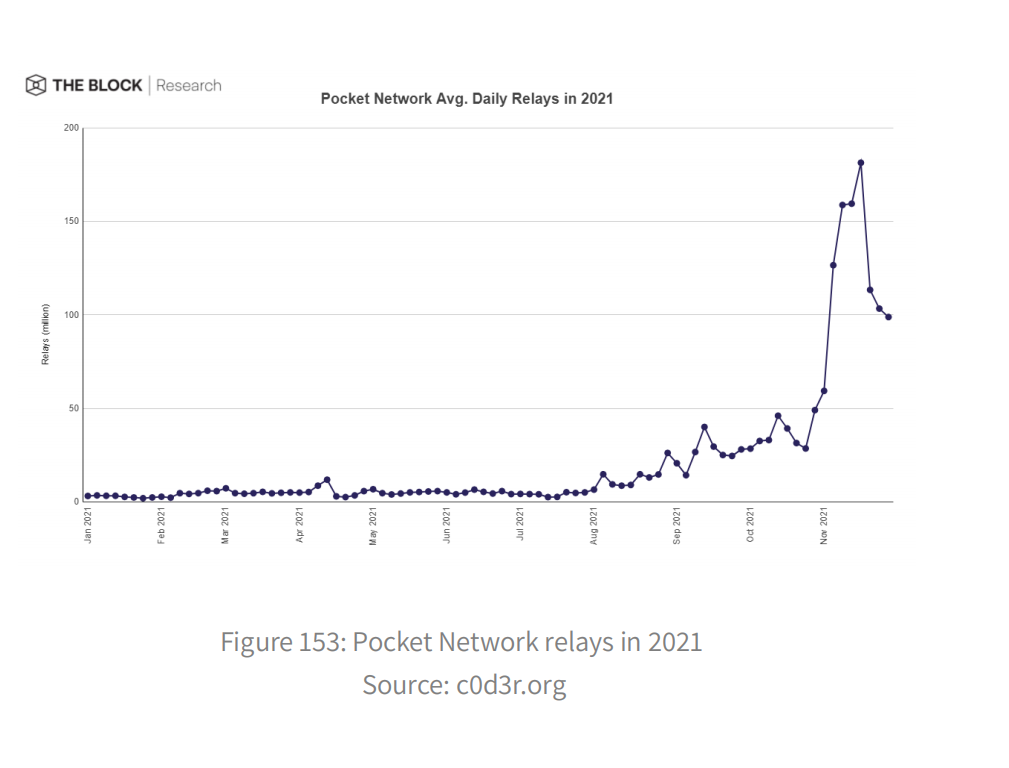
Pocket Network usage has seen huge growth this year, particularly with the explosive growth of web activity that began in October. What are the main drivers? First, in February, Pocket Network announced that they would start providing the Ethereum infrastructure for Fuse, a platform for building decentralized payment systems. As an Ethereum side chain, Fuse requires a stable, well-functioning FUSe-Ethereum bridge. By integrating with Pocket, Fuse can further decentralize the platform, increasing user privacy while reducing the cost and efficiency of running your own Ethereum nodes.
Then, in August, Pocket announced support for xDai Chain, another Ethereum side chain that supports xDai staboins, which are bridged from Dai on Ethereum. One of the main use cases for xDai is to enable fast and low-cost transactions in the MMO space conquest game Dark Forest. Similarly, by integrating with Pocket, xDai can increase decentralization while "outsourcing" their Ethereum infrastructure needs.
More recently, network activity surged from October after Pocket announced it would handle Harmony RPC traffic. Harmony is a Layer 1 blockchain that can be used as an interoperable layer 2 extension solution for Ethereum by using random state sharding, allowing secure block confirmation at low cost and high speed. Harmony's network had between 50 and 100 million API calls at the time, and they were trying to re-route traffic through scalable and decentralized apis. Developers can now create Harmony RPC endpoints from Pocket's front-end API portal to use in their Dapps. These pocket-driven endpoints provide an additional layer of flexibility, reliability, and privacy for dApps.
In Pocket network, application peg is the entry point registered as an application in the network. The application locks the POKT into a binding within the network to receive throughput allocations performed over network node relays. The binding rule is determined by the monetary policy and protocol rules set by Pocket DAO. As the chart below shows, the amount of POKT that applications use to reserve relay requests has grown more steadily since the beginning of the year.

The daily reserve of relay requests is equal to the number of POKT bet by the application multiplied by 40. Then, we can see that the application has "paid" (invested enough POKT) to reserve nearly 1 billion relays per day while using about 160 million, or 16% of the reservation. This is not surprising, however, as applications should have a backup buffer to deal with a surge in network activity. Eventually, assuming these held tokens deplete the reserve of relay requests, the approximately 1 billion relays will be paid as "revenue" to relay providers, Pocket DAOs, and POKT block producers. Now let's look at these benefits and rewards in more detail.
Income and return
To convert trunks into revenue, simply multiply the number of trunks by 0.01(number of POKT generated per trunk) and POKT price. The figure below shows monthly POKT revenue for 2021, based on average daily access points and monthly POKT prices. Price data is available from April to November.
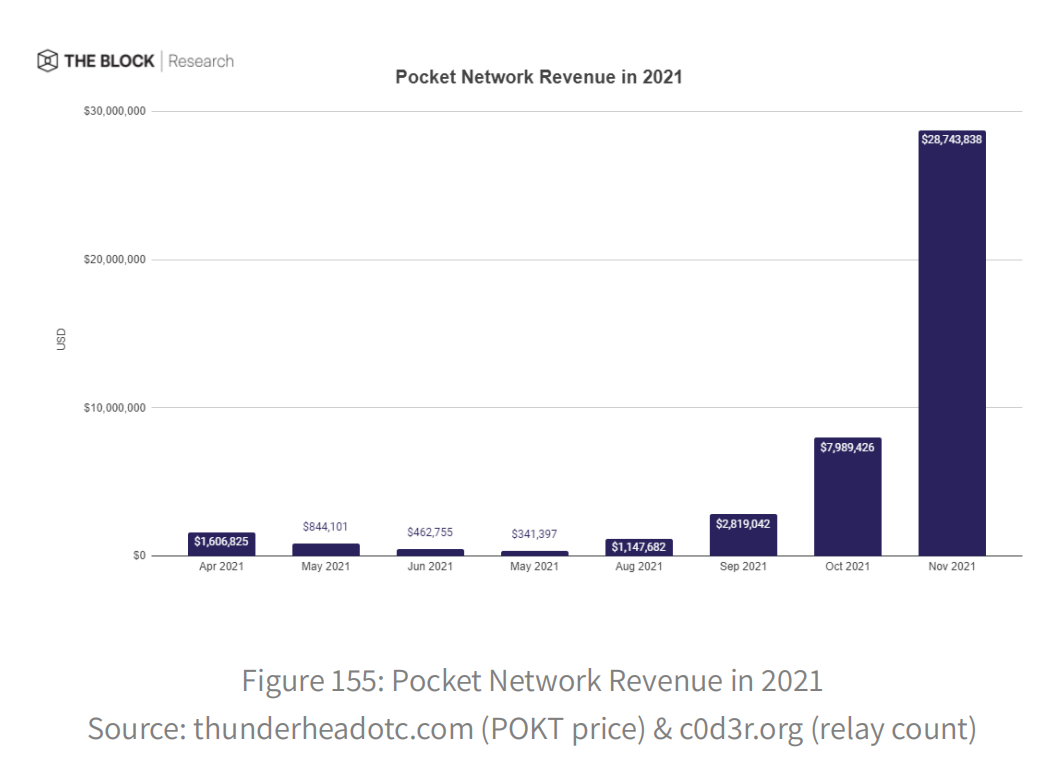
Network activity decreased from May to July, at the same time as overall activity in the Ethereum network and crypto market decreased. But Pocket apparently saw a big jump in revenue this quarter after building terminals that connect to Harmony's network. We can also look at how many POKT get per relay node the number of relay nodes divided by the total number of relay nodes and multiplied by 0.89(from 89% of distributed POKT service nodes, pocket knives,10% and 1% block producers). The chart below shows the average daily rewards for each verified node from January 1, 2021 to November 8, 2021, four days apart.
At the beginning of the year, POKT nodes received more daily rewards because there were fewer nodes in the network. The chart below shows the number of active validator nodes in the network from January 1 to November 8, four days apart.
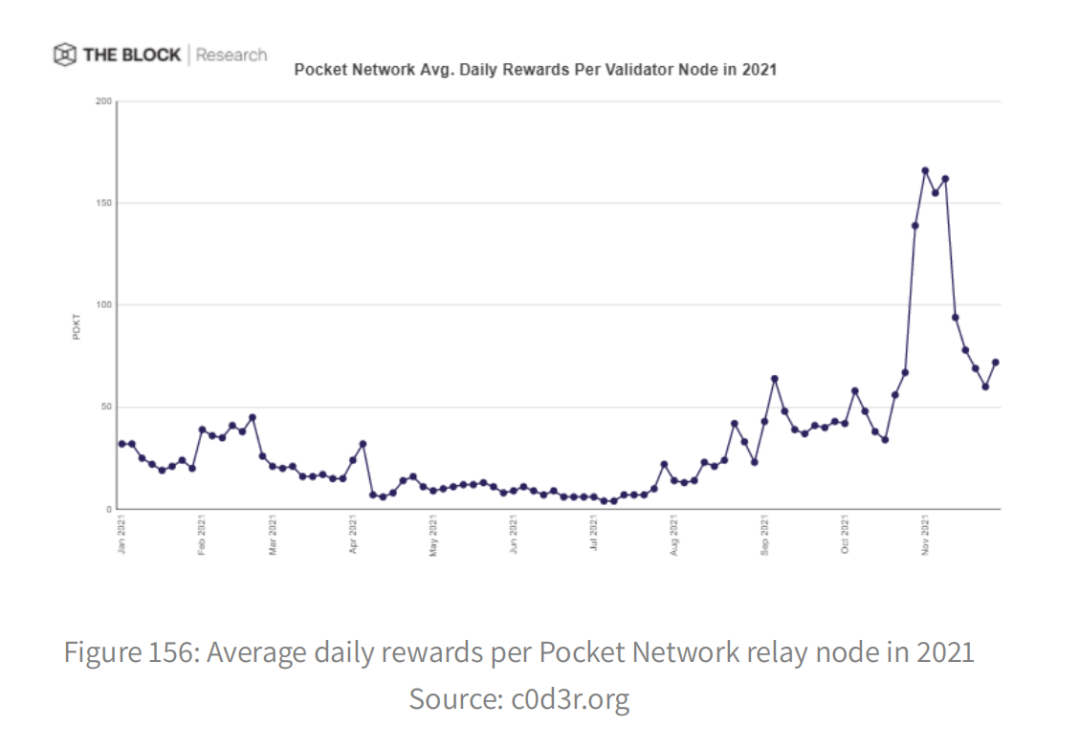
To date, active validator nodes have increased more than 15-fold since the beginning of the year, from just over 600 nodes to over 9000 nodes today. This month, the average daily rewards per validator node soared to an average of 161 POKT(~ $118 $0.73 / POKT) per node per day, coming out over 300% of the minimum number of POKT rewards per node in the network (assuming a share of 15150 POKT per node).
These rewards are not necessarily sustainable in the long run. Attractive returns may lead to more node providers, further separating the total verifier reward from the POKT reward paid through supply dilution (creating 0.01 POKT per delivery). There is also the question of whether compensation paid through supply dilution should be considered income. On the one hand, they do represent the real needs of Pocket services. On the other hand, the interests of the application and nodes will be diluted every time the work is performed on the Pocket network.
At the November peak, that would add about $412m a year to the market. That said, Pocket DAO may vote to curtail new POKT releases in the near future. Moreover, despite these staggering numbers, Pocket Network can still handle only a fraction of the traffic of its concentrated competitors, with Infura alone serving more than 2.4 billion Ethereum relayings a day in 2020.
Due to the huge potential market and the success of harmonizing with the integration of other protocols with pockets, we can see an increasing number of protocols rerrouting and decentralizing with pockets of transportation networks that raise the dependency of prevention or response issues with centralized blockchain infrastructure. Whether this decentralized infrastructure can support a Web3 economy with billions of DApp users will depend on the resilience and ideal anti-vulnerability of node and network technologies.
The emerging Web3 economy
To conclude this chapter, we'll look at some data on the emerging Web3 economy to get a sense of where we are and where we're headed. While there is no single metric to track overall Web3 development, we can look at several proxy metrics that track different aspects of Web3, from DeFi to NFT to adoption of Web3 front-end applications such as wallets. Below, we plot all unique Ethereum addresses and unique Ethereum addresses that interact with the DeFi protocol from January 1, 2016 to November 17, 2021.
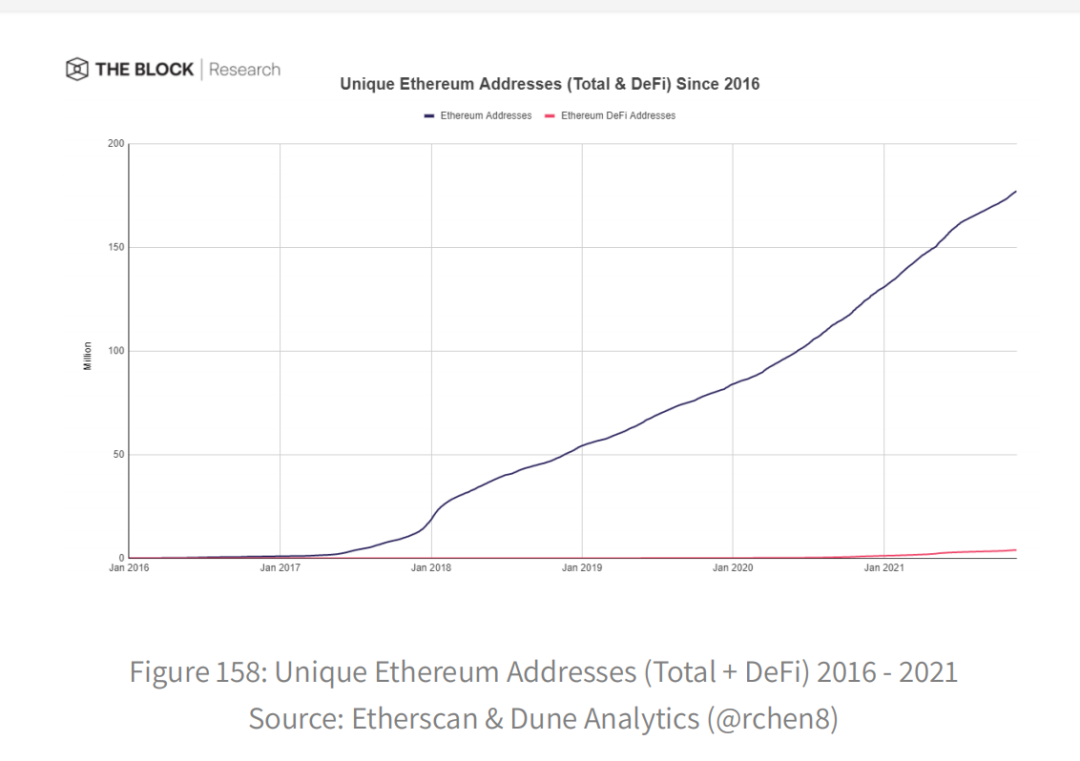
The total number of unique addresses on Ethereum has steadily increased since the beginning of 2018. Ethereum's unique addresses have grown by an average of about 52% a year since the start of 2019. Ethereum addresses interacting with the DeFi protocol have also exploded since 2019, growing by about 700% yoy, but slowing slightly from around 875% yoY from 2019 to 2020 to around 500% yoY from 2020 to 2021. Currently, only 2% of Ethereum addresses interact with DeFi, but that's still more than double the 0.9% at the beginning of 2021. DeFi still seems to have a lot of upside potential.

Another agent that tracks the NFT transaction submarket in the Web3 economy is the total number of unique wallets that buy or sell non-functional transactions. There are varying degrees of significant month-on-month increases - for example, 8% in January-February, 28% in February-March, 10% in May-June, and 35% in August-September. Overall, the number of active wallets in the NFT market has grown 600% this year alone.
We can also use the number of monthly active MetaMask users as a proxy for Web3 economic activity. Below, we've plotted the monthly active user accounts provided by Consensys from the beginning of THE first quarter of 2020 to the end of the third quarter of 2021.

In July 2020, Consensys reported that MetaMask had 550,000 monthly active users. By August 2021, there were more than 10 million, an increase of 1,800% in about a year. A brief look at the Web3 economy from these perspectives really helps to understand the hot topics behind Web3 and the explosion of vc interest in supporting projects in these areas, from DeFi to NFT to gaming. Given the upward trend over quite a long period of time, we can begin to have some confidence that Web3 is indeed beginning to consolidate itself outside of the Web2 architecture.
These new user experiences are enabled by decentralized, secure, immutable databases such as blockchains;
New ways to simplify access to data structures using token incentives, economic games, and cryptographic proofs;
And a series of new tools for Web3 prototyping and development.
Chapter 7: NFTs and Blockchain-based games: Overview of 2021, Vision for 2022 & NBSP;
Data-driven overview of NFT and blockchain-based gaming landscape, growth metrics, theme highlights, and more.
The profile
-- $8.8 billion in non-functional transactions, 59% for art and collectibles and 41% for games;
- Blockchain-based games have found a product market suitable for the new business model, where game developers can oversee the entire lifecycle of in-game assets while earning fees from secondary market transactions and introducing users to the interoperability of their assets and potential in-game revenue;
- High gas costs have forced non-deliverable transaction activity from Ethereum to other tier, side chain and tier 2 solutions.
2021 was a good year for cryptocurrency assets, but one could argue that non-cryptocurrency and non-crypto-based games went from zero to zero this year. From Beeple's non-cryptocurrency transaction selling for $69 million, to celebrities wearing CryptoPunk and Bored Apes, to PayPal buying cryptocurrencies, To major art auction houses like Christie's and Sotheby's embracing non-crypto trading, a spate of events in 2021 has brought non-crypto trading into the zeitgeist. Against the backdrop of many themes, there are two larger themes driving the rise of NFTs. First, the market sees NFT as more than just "right-click and save." It began to price real ownership of digital collectibles. Second, game business models that allow players to own and freely trade game assets allow game developers to even earn fees from secondary market transactions. From the developer's point of view, this behavior is part of an opaque gray market.
The number of non-functional transactions can be broadly divided into two categories -- art and collectibles, and games. In general, art and collectibles non-functional testing is not actively used, while game non-functional testing is used in games. Although the entire NFT movement was sparked by art and collectibles, game NFT games began to gain a share of the market. As of Nov. 30, the two categories accounted for $8.8 billion in total transactions, with 60 percent coming from the art and collectibles category and 40 percent from non-functional games transactions. Non-functional trading activity peaked in the third week of August at just over $1bn. Since then, weekly sales have dropped dramatically, particularly in the art and collectibles categories, while NFT activity in games seems to be even more robust, at around $150 million per week.

The average face size of artwork and collectibles is several orders of magnitude higher than the NFT of the game.
However, compared to art and collectibles, game non-functional games have a higher speed and make up for their price with a high volume of transactions.


It's no surprise that in the Art and collectibles category, Bored Ape Yacht Club, CryptoPunks and Art Blocks dominate.

While the three companies dominate in volume, NBA TopShot leads in number of deals.
In gaming, AXI Infinity is the leader in weekly sales. Interestingly, Axi Infinity started to perk up with the release of side-chain Ronin in May.
NFT market & have spent
From $17.9 million in January 2021 to $2 billion in November, the total monthly transaction volume of the NFT market increased 133-fold. From non-existent in January to facilitating $2.3 billion worth of non-functional transactions, OpenSea's rise as a market has been stunning.
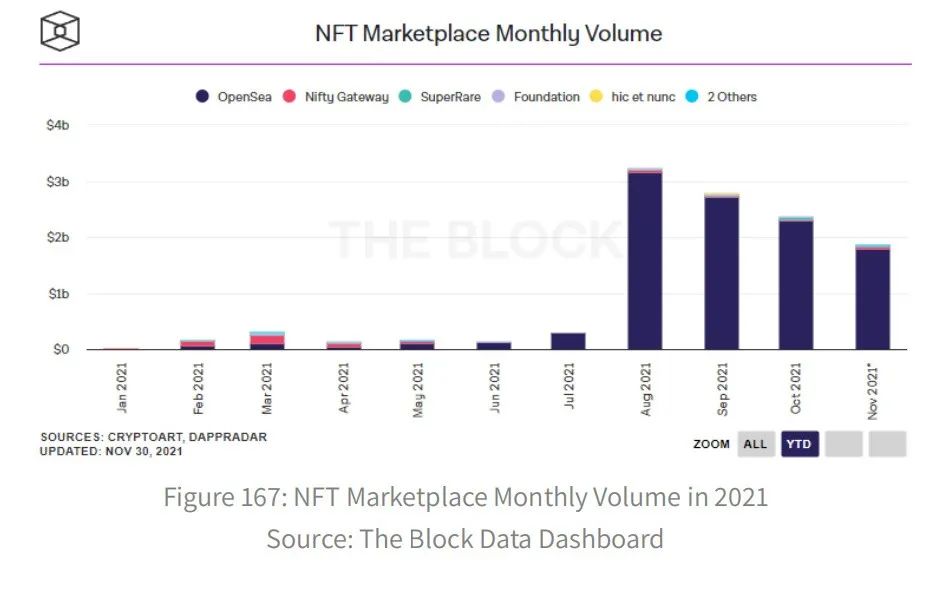
Axie Infinity has over 9.2 million lifetime transactions, almost double the CryptoPunks of the best NFT collection below. Ethereum is still the dominant blockchain in terms of secondary sales. With sales of $9.3 billion, it was nearly three times the second-best Ronin in the secondary market. However, it must be noted that these are unprecedented comparisons and Ethereum is already ahead of side chains or other layers.
The following table shows the total sales for different collections and blockchains:
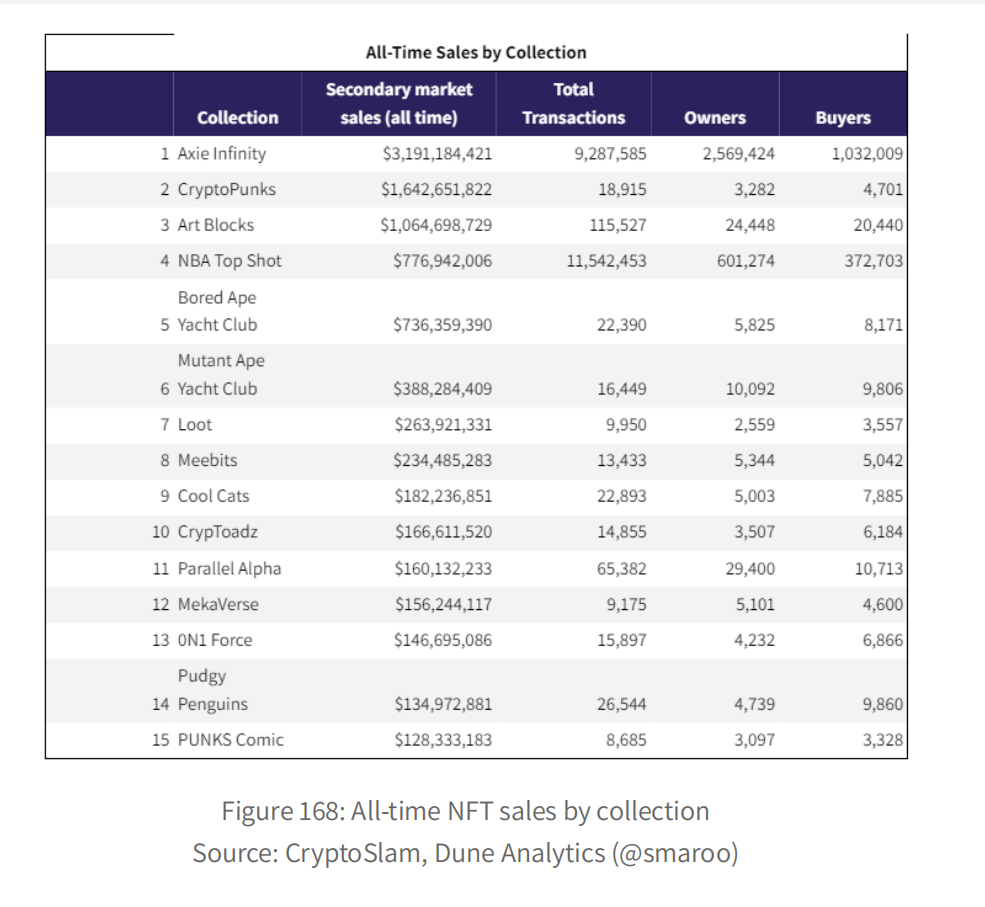
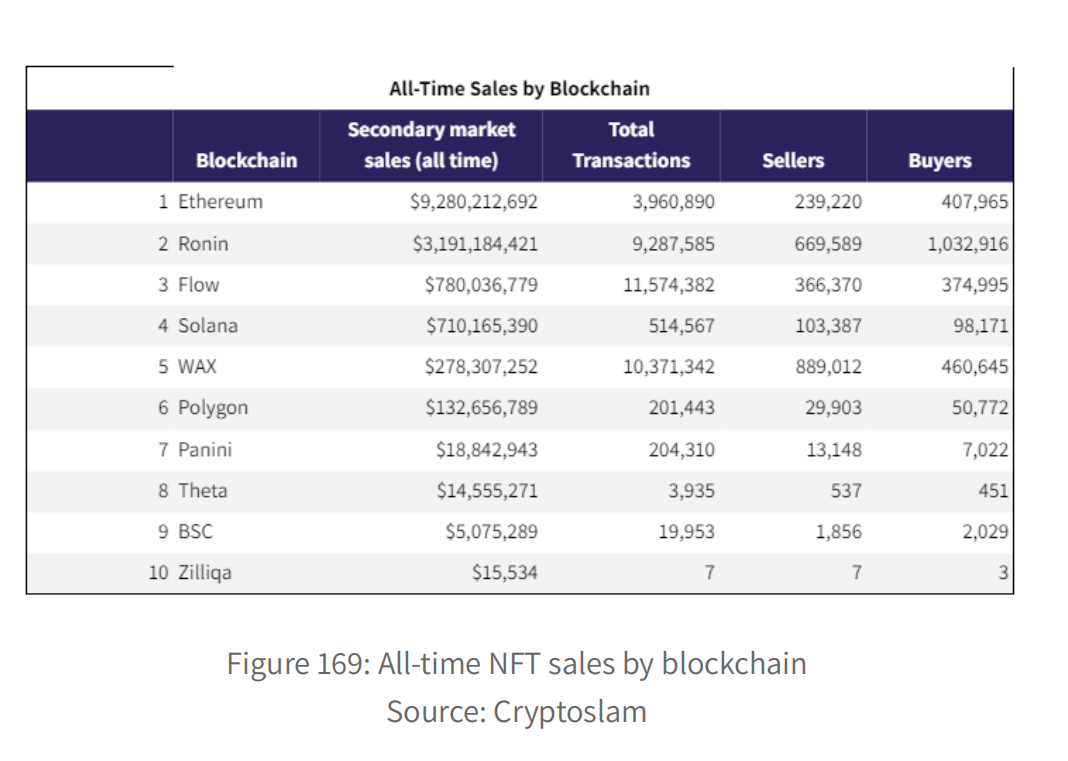
2021 NFT and blockchain game theme
The game business model will change dramatically in 2021
NFT allows digital assets to be seamlessly integrated into a game, giving players real ownership of their game assets. On the one hand, it allows players to earn money by playing the game, and on the other hand, it allows game developers to track the transaction of game assets in the secondary market and earn fees. In essence, gray market activity that was opaque to game developers is now being replaced by transparent exchanges, increasing developers' ability to monetize their games. When players are confident in their possession, they are more willing to spend money upfront. In our report we delve into the meaning of NFT in games, the state of blockchain-based games, and blockchain-based games - the Introduction to the metaverse.
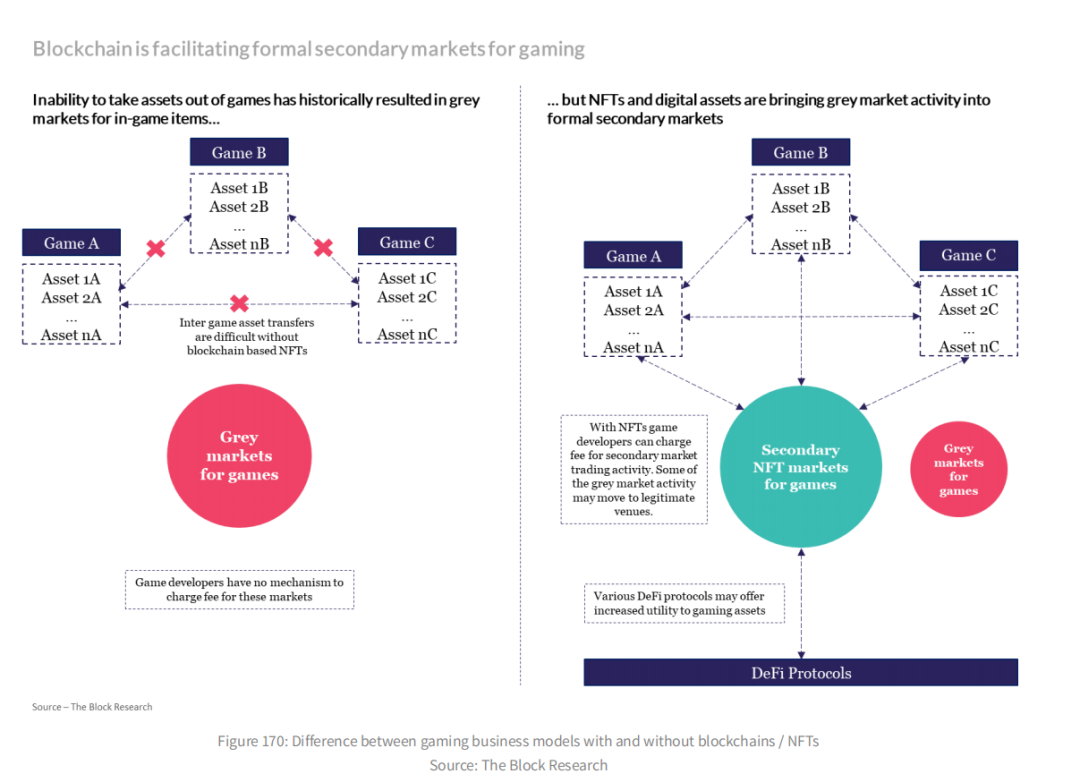
Multiple games use different symmetrics to determine which stakeholders gain value at which points in the game's life cycle. Striking a balance between an immersive gaming experience and motivating players to participate is an important consideration for game developers. While the blockchain gaming market is still in its infancy, the chart below shows how the gaming ecosystem is changing today.
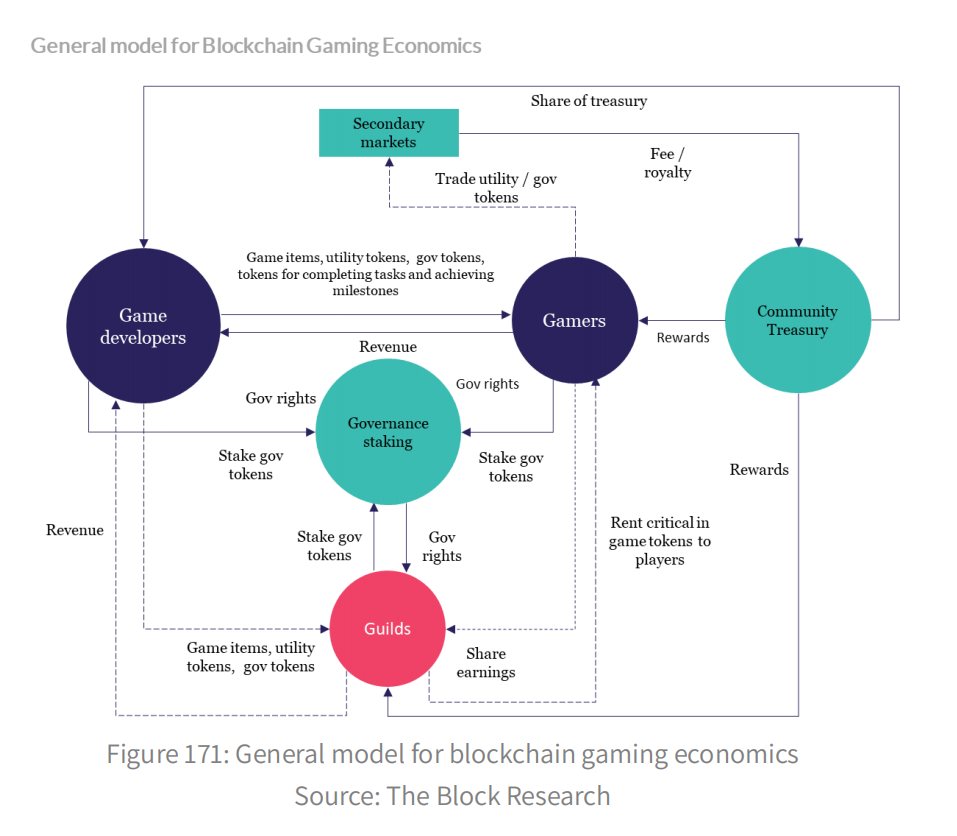
The rise of game guilds
The ability to make money from games opened up new business models, and game guilds were one of them. Guilds support players from entry to rental of necessary in-game assets in return for a portion of the player's in-game revenue. Most unions are organized as DAOs (decentralized autonomous organizations). One of the reasons why guilds have become such an important part of the gaming ecosystem is that as games become more popular, in-game assets required for games become more expensive. For example, you need three Axes to play Axis Infinity, and the total cost of acquiring them is around $360, which is three times the price of the most expensive game on Steam, the leading digital game service ($119). This makes the barrier to entry too high for many players. In this case, the guild buys, breeds and rents Axies to players. Then take 20-30% of the player's revenue in return. Yield Guild Games, Merit Circle, Avocado Guild, AAG Ventures, and Blackpool are some of the more prominent guilds in this ecosystem.
Financing in the games industry is growing exponentially
2021 has been an extraordinary year for NFT and blockchain-related fundraising. The sector has raised close to $28bn. And that doesn't include the IDOs in the game. The table below lists the top 10 fundraisings this year by companies in the sector.
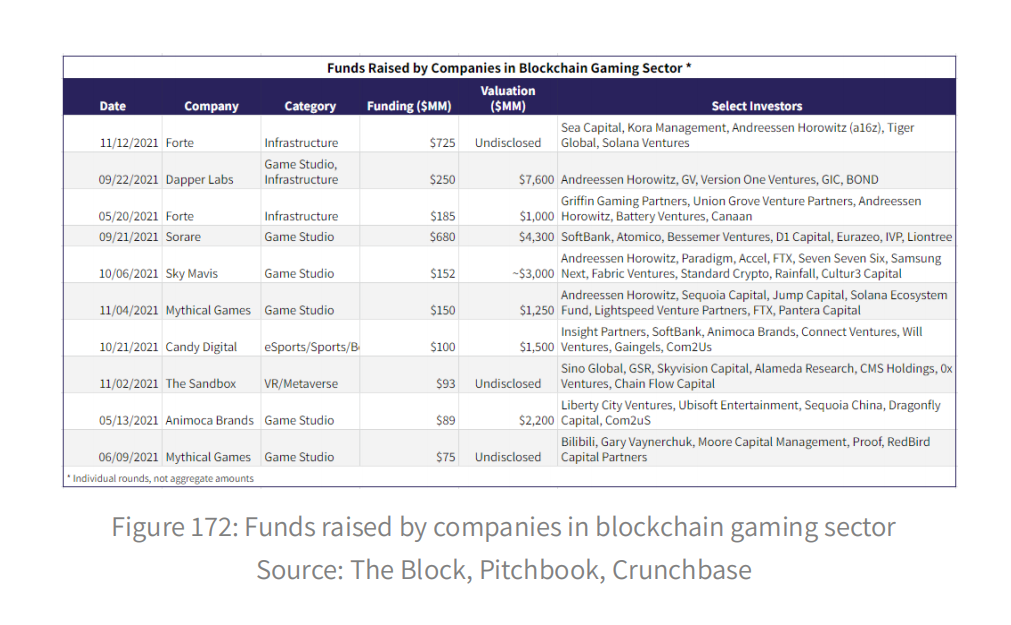
In addition to companies established in this space, some crypto natives are raising money in three different ways -- venture capital, ICO/IEO (Initial Exchange Offerings) -- where new projects use existing exchanges as distribution platforms for token sales, And NFT sales. The table below shows the amount of money raised by major games in the space.
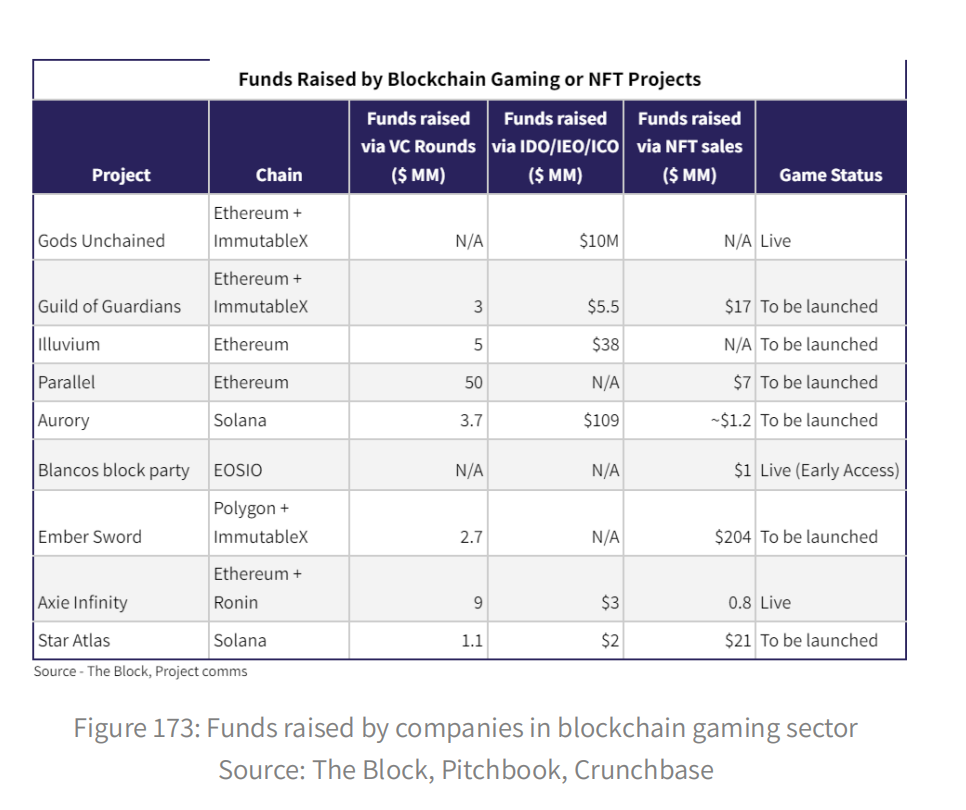
Higher natural gas prices have encouraged the development and use of Ethereum side chains and other blockchains
Natural gas prices on Ethereum have been high since DeFi started in the summer of 2020. Non-functional transaction activity on top of continuous DeFi makes the base layer of Ethereum unusable for smaller market participants. We've seen developers take different approaches to help extend NFTs beyond the ethereum base layer.
We encounter an interesting dichotomy about the appeal of NFT, between public interest and practical use. To be more precise, Google searches for "NFT" and "OpenSea" (which are generally good proxies for understanding NFT interest) have been on a steep upward trend since July, even hitting all-time highs in September and November, respectively.


Contrary to this trend, the total market for NFT has been declining significantly since August, which seems counterintuitive at first glance.

Dig deeper, however, and this is happening against the backdrop of soaring ethereum gas fees as well as soaring prices for underlying assets such as ETH or SOL. This trend has occurred during the same period when volumes in the NFT market have declined significantly.
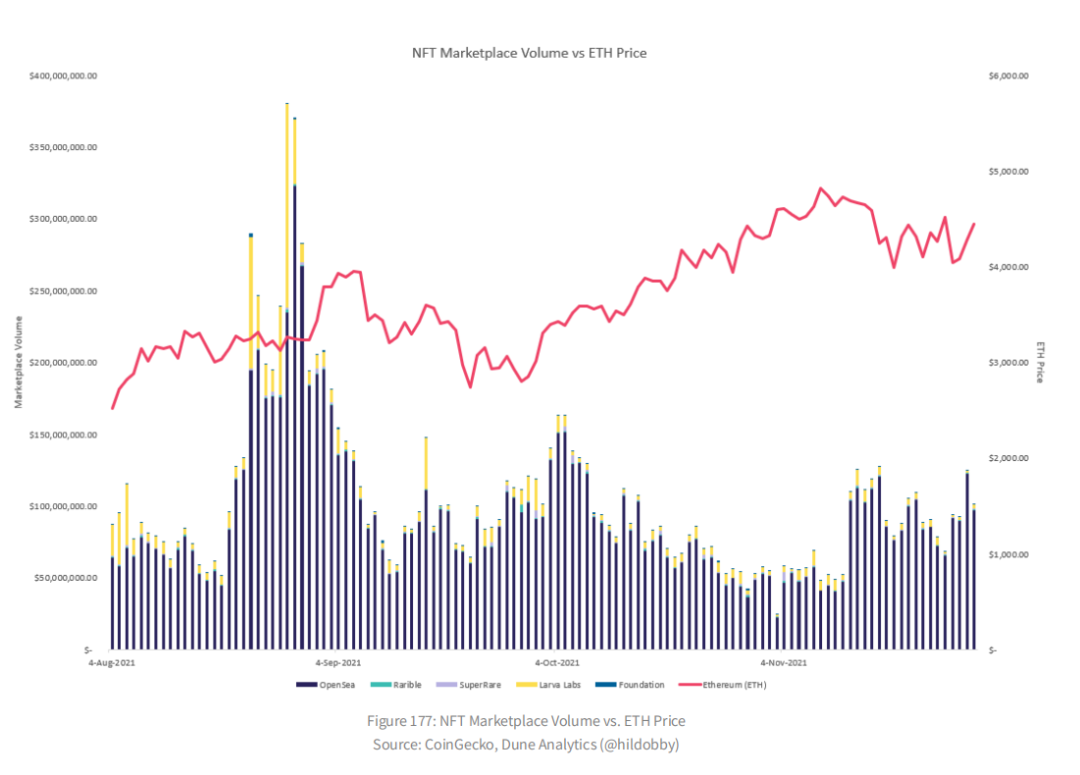
Thus, the two main drivers of this bifurcating trend are soaring investment and transaction costs, which make it impossible for most individuals who are still denominated in us dollars to join and participate in non-functional financial markets across the chain. This once again underscores the increasingly critical requirements for L2 extension solutions (see the Layer 2 Platform section of this report).
CryptoKitties creator Dapper Labs has released Flow, a new blockchain for NFT and games. Sky Mavis, creator of AXI Infinity, launched side-chain Ronin in April 2021. Ronin had a surprising influence on the development of Infinity Axis. As of August 9, the game's daily active users (DAU) had grown 16-fold in less than four months, passing 1 million DAU. Immutable, Gods Unchained's company, launched Immutable X, the first Ethereum 2-tier extension solution tailored for NFT, in April 2021.

A recent episode made it clear that much of the nascent NFT market still resembles uncharted territory. After an argument with another community member, the lead developer of Hic Et Nunc (HEN) decided to shut down the site on a whim. This was possible because he was the only community member who had the Github key to the project. This incident underscores once again the importance of true decentralization. HEN community decided to establish a new community-led Hic Et Nunc in response to this turn of events.
Metaverse is coming.
From Microsoft to Facebook, just about every tech company is talking about their vision of a global world. The term "meta-universe" dates back to Neal Stephenson's 1992 novel "Snow Crash," in which he referred to the meta-world as a persistent virtual world. The idea is that the meta-world is a real-time 3D social media in which people collaborate and participate in the economy.
While there is no agreed definition, there is overlap between different views. A common aspect is how the meta-universe will become part of the digital economy. If so, maintaining ownership and proving digital scarcity will be an important attribute of the yuan world. It is difficult to imagine a metacreage without blockchain and NFT, as they already have the characteristics of a metacreage.
New primitive elements of the game are being tested
In the frenzy over NFT language speculation, experimentation in unconventional ways also flourished, leading to the birth of new hominids. Loot is a great example of this kind of experimental innovative thinking and is a prime example of the untapped long-term potential of NFTs. Loot is randomly generated adventure gear stored on a chain. Instead of the traditional top-down approach, where project developers create NFT games with a front end and embed them in a player-accessible environment (collect, crypto games, etc.), Loot takes a bottom-up approach. Under this approach, the collector creates only the base layer of NFT around which the community can collectively build the context and front end. For example, shortly after Loot was released, the community released Adventure Gold (AGLD), a token that served as the basis for in-game currency and management.
In short, loot represents a kind of composable "DNA" that can be plugged into different games, as the "DNA" code based on a given loot pack presents a visual representation of the adventurer's equipment and additional features. In that sense, you can peel back the imposed preconceptions, much like using virtual reality in a pre-built crypto game, and give design freedom back to the community. Given the novelty of the project and developer Dom Hofmann, co-founder of Vine, a six-second video social app, Loot went viral and pushed the base price to $53,000 on September 3, He eventually settled on around $15,000.
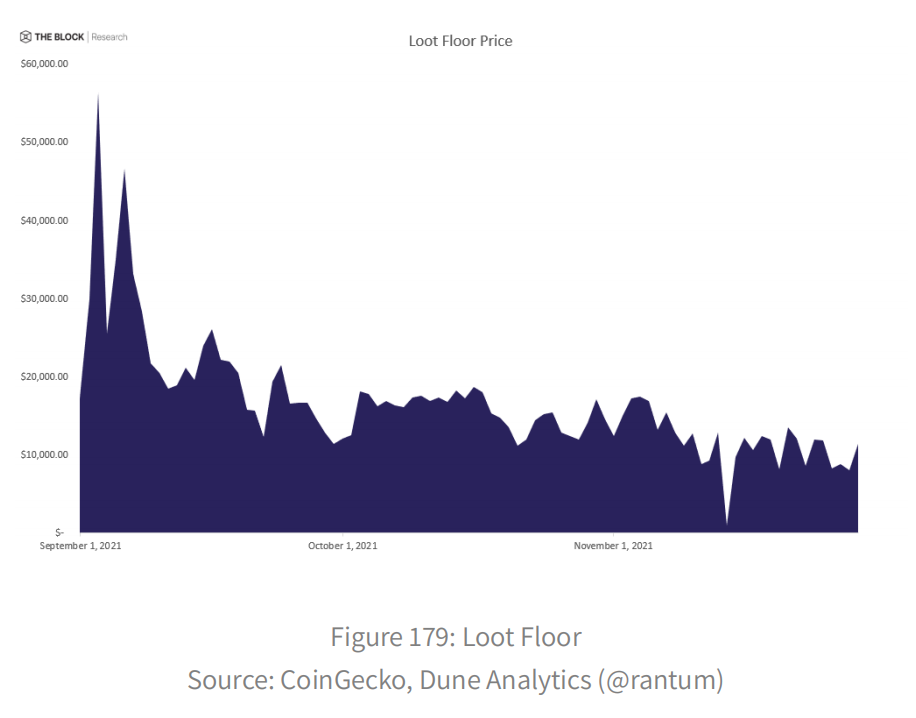
It was quickly realized that paying at least $15,000 for a ticket to get into a booty based game wasn't feasible for most people (except for a few crypto whales), which could hinder the spread of the ecosystem. As a counter, we created extensions such as Synthetic Loot, which allows free access to the Loot ecosystem through "Synthetic" NFTs. In this way, Loot ecosystems can be put on a more sustainable path. All in all, this movement shows the potential of a community to build on a blank canvas that can be composed.
NFT games were released primarily on a first come, first served basis, which ultimately led to gas wars and made it impossible for the average user to succeed.
When Larva Labs launched CryptoPunks in 2017, they were free, and gas on Ethereum was cheap, averaging $5.70. The CryptoPunks, however, took several days to photograph. Today, almost all expected NFT releases are filled with bot activity and fully generated within a few blocks, despite exorbitant gas bills putting the average Ethereum user out of reach. Projects like Parallel are trying to start NFTs fairly by eliminating air warfare, as they allow buyers to complete conversion within 24 hours of purchase. In our research article A, we found that A fair release of A non-functional game is timeless, immutable, and untrustworthy.
2022 NFT and blockchain gaming outlook
The current value proposition for crypto games is built on an unsound foundation.
With interest rates at historic lows almost everywhere in the developed world, the cost of capital is low. Since many investors are flush with cash, almost every game project has a seed round at a valuation of its own choosing. While IDO amounts to between $1 million and $3 million, the project has been raising money through other means, such as pre-selling in-game NFT.
In game earning mode, when a player earns money, someone must be debited. It can be a market participant with a positive view of the game's prospects, or it can be protocol token inflation. In addition to market participant or protocol token inflation, advertisers can subsidize players as a meaningful way to interact with their end consumers. While we haven't seen the full effect of this yet, FTX has sponsored some players in Yield Guild, an example of a company targeting non-functional gamers. It's important to design simple and effective game loops. When the market gets worse and there's not a lot of money floating around, it's hard to keep attracting new players.
Therefore, there should be other features that appeal to players besides the "earning" aspect. Despite the fact that some games are boring to play, proponents of the money-making model often argue that these games need to be more fun than traditional mundane work. This argument misses the point that, mundane as the job is, it adds value to others. For example, commuters pay taxi drivers because the drivers facilitate their commute. If other people can't get value from the people playing the game, then it's hard to believe that anyone will fund players forever.
The money glut hints at the similarity of the 2017 ICO boom.
Nonetheless, the game and NFT fundraising story is similar to that of icOs in 2017. The Unity package for building a game is the equivalent of a white paper. However, a small number of games will add real value to players by using censor-resistant blockchains. The same is true for NFT and PFP.
Many projects across different chains have rolled out limited (typically 10,000 or 8888)NFT to induce scarcity. Scarcity alone, however, does not make things valuable; It needs to be combined with a need to be valuable. Not every PFP can be a cryptocurrency, just as not every token of work can be a bitcoin. Beyond technical capabilities, there is a social consensus that cryptocurrencies and Bitcoin have value. CryptoPunks and Bored Apes are valuable because they are archetypes; They started the movement. The NTH derivative of an ape is of no value.
Beauty lies in the eye of the beholder. This is especially true for nonfunctional memory disorders. The value of an NFT project is much more subjective than a DeFi or infrastructure project, such as the story of the project, its artist, and whether the NFT test will bring material utility in the future. When there are so many intangibles to consider and value is not obvious, people may turn to public figures or influential people for value signals. The first NFT projects, such as Cryptopunks, didn't have to fight for their place in the NFT world; they emerged organically because they were historically important. Instead, new projects must compete for a psychological share of potential buyers. With so many PPP projects flooding the market, influencers have reached king status.
Multi-chain scale-out solutions are likely to drive large-scale adoption of NFT
It is no exaggeration to say that interacting with NFT at the base layer of Ethereum is for the rich. Facilitating cheaper transactions on decentralized networks like Ethereum is crucial if the goal is to foster widespread adoption of Web3. As we noted earlier, the second half of 2021 saw the launch of tier 2 extension solutions on top of Ethereum, such as Optimism, arbitration, and ImmutableX. However, many users have migrated to other chains such as Solana, Avalanche, Binance Smart Chain, Fantom, and Harmony. One of the reasons for adopting other Layer 1 platforms is that they have projects and users ready before users can use ethereum Layer 2 infrastructure. Ground-floor companies like Solana, Avalanche, Fantom, Algorand and Harmony launched massive incentive campaigns to encourage projects to be built or ported on top.
In addition, as we highlighted in the Layer 1 section, cross-chain Bridges accelerate the adoption of NFT between layer 1 networks. For example, the AnySwap protocol recently announced support for NFT Bridges between Ethereum and Fantom, and Wormhole V2 Bridges between Ethereum and Solana.
The user experience journey of Ethereum Layer-2 extension solutions such as Optimism and arbitration is different from other Layer-2 networks, mainly because it involves additional steps and costs, as users must transition funds from the base layer of Ethereum to Layer 2. As of November 30, the number of Bridges to these second-tier solutions outside ethereum is limited. This means that users who want to use arbitration or optimism must first deposit money into Ethereum from a centralized Exchange and then transfer it to a second-tier platform via a bridge like Hop Exchange or Celer. As a result, users not only have to pay high gas bills, but also have to pay a variety of transaction fees. However, most centralized exchanges currently offer withdrawals directly to other Layer-1 networks, which greatly reduces transaction costs and eliminates the need to interact with Ethereum.
While other blockchains have made some headway on Ethereum, a variety of catalysts could propel ethereum forward. For example, ImMutabx, a tier 2 solution specifically for NFT and games, is available in April 2021, and OpenSea will support NFT transactions directly on ImMutabx. Ember Sword, a popular MMORPG, recently moved from Polygon to Immutababt. In 2022, we may see centralized exchanges facilitate second-tier solutions that extract directly from Ethereum. All of the developments related to scaling solutions mean that Ethereum may still be the first step in getting users comfortable with NFT and Web 3.0.
As we point out in our research article "Unraveling the Yuan World #1 -- The Rise of Multi-chain Non-functional Trading Markets," we can see non-functional trading activity spreading beyond Ethereum. If NFT continues to thrive on other chains, solutions that enable interoperability will be critical.
The meta-universe is coming, albeit slowly
After Facebook changed its name to Meta on October 28, 2021, the discussion about Meta has gone mainstream. But is the metasverse here? In one form or another, it already exists. Social media platforms, AR(augmented reality) games and apps, and virtual reality devices like Oculus are all movers and shakers of the metaworld. The footsteps of digital parties speak to the widespread interest in digital interaction and transactions.
However, today's solutions are centralized and don't give users much power. NFT and blockchain allow users to truly own their digital assets, trade more freely in the digital world and thrive in the crypto economy. Today, each blockchain has its own ecosystem of side chains, two-tier solutions, decentralized transactions, and more. Blockchains typically have Bridges connecting to other chains, but the experience of moving assets from one blockchain to another is far from seamless. See if more generic protocols (such as Cosmos' Inter Blockchain Communication (IBC) or Polkadot) can ease today's friction and enable seamless cross-chain transactions.
While NDT and digital assets can generally help implement some aspects of the metasomes, we may have to wait a while before experiencing the full metasomes.
The next step in NFT publishing is to unlock fair publishing
Projects like Parallel Alpha are experimenting with new mechanisms to enable NFT. One of their first attempts was to avoid gas wars by allowing gas bills to be paid within 24 hours. They also integrate the Chainlink Verifiable Random Function (VRF), allowing contracts to access randomness without compromising functionality or security. This will help give all users equal access to rare NFS. The current infrastructure may support a fair way to start NFT, but doing so can make it more complex to start, such as closing transactions within 24 hours of purchase and driving out non-technical participants. Therefore, for NFT project teams that want to clear NFT sales as quickly as possible, this can be detrimental. Therefore, as long as the release of new non-functional tests is stopped within a few blocks, fair release is unlikely to be a widespread priority.
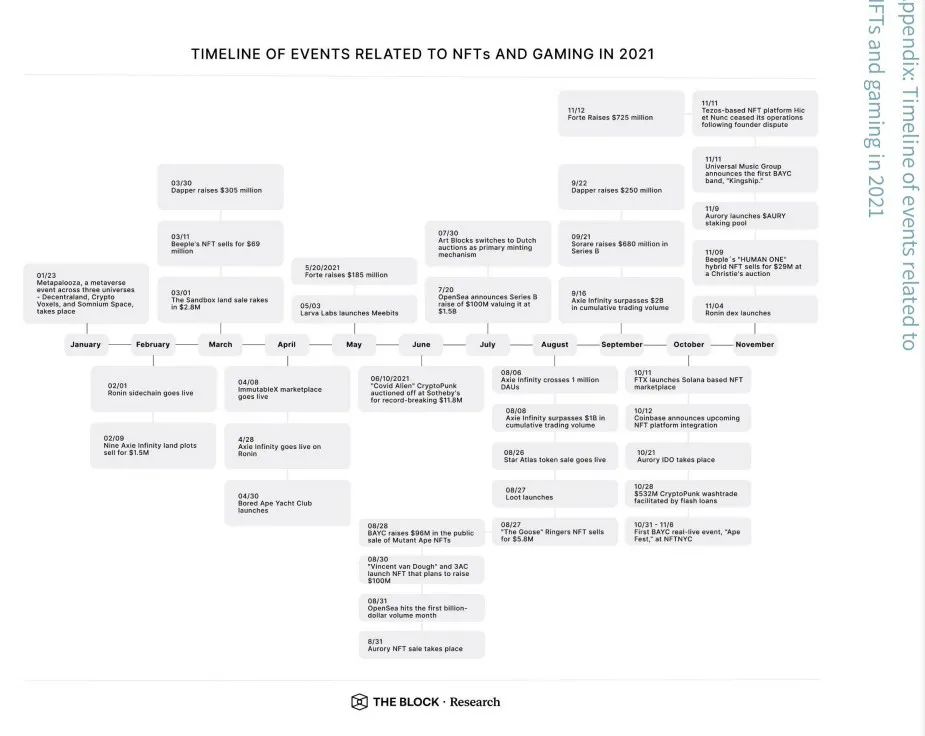
Chapter 8: Macro Outlook: Overview of 2021 & NBSP;
Supported by a range of external macroeconomic catalysts, the digital asset industry's bull cycle has continued into 2021, as well as mainstream and institutional participation in different sectors of the industry.
Review the major developments in 2021
This section contains four timelines, broken down as follows:
- Public sector activities: Key decision makers, particularly central banks and local and national leaders, are continuing to adopt digital assets, albeit in different ways. While the central Bank digital Currency (CBDC) effort is being experimented after the 2020 publicity cycle, we also see local and national governments starting to adopt cryptocurrencies in 2021.
- Institutional adoption: Financial institutions and businesses are becoming more active in the crypto space. In 2021, banks significantly enhanced their cryptocurrency custody capabilities while increasing their trading desk staff. Investors now have greater access to structured products such as futures ETFs, although efforts to offer physical ETFs continue to be rejected in the US. In addition, in 2021, it became more common for companies to accept Bitcoin and other cryptocurrencies as payment methods and to hold bitcoin on their balance sheets.
- Changing regulation: Regulators have been very active this year, with several countries banning bitcoin, macroprudential regulators increasingly focusing on Stablecoin and regional financial regulators beginning to scrutinize crypto businesses with greater scrutiny.
- Mainstream metadata :NFT and blockchain-enabled metadata have brought a new wave of mainstream adoption and attention to the digital asset industry in an unprecedented way this year. The main highlights are auction houses selling non-cryptocurrencies, wider participation in crypto assets, and big brands using non-cryptocurrencies to attract new audiences. Finally, large companies around the world are embracing this meta-world through announcements and investments.
Public sector activities
CBDC is growing slowly
With a flood of research papers and pilot announcements, 2020 saw CDBC move from a niche idea discussed by economists and blockchain enthusiasts to a potential reality in large and small countries and currency areas. Dialogue in key policy and regulatory circles has increased in 2021, but progress in most developed currency areas appears to be years away. In 2021, the Bank for International Settlements (BIS) consolidated its role as the leading authority and facilitator of international CBDC trials.
In June, THE BIS Innovation Centre opened innovation centres in Northern Europe and London, extending the programme to five regions. In addition, key cross-border CBDC projects overseen by the BIS, such as the mCBDC Bridge and The Dunbar Project, published their findings.
2021 does not present many clear-cut problems for potential DOLLAR CBDCS. 'Given the international importance of the dollar, the Fed will maintain a significant advantage whenever it decides to issue a CBDC,' Fed Chairman Jerome Powell said in a Statement in March. That does not mean, however, that the Fed has ignored the problem. The Boston Fed, which has a payments team, has been studying the CBDC for the past year and is expected to release a discussion paper by the end of 2021.
In addition, THE CBDC has begun to be discussed by US lawmakers. In Europe, Christine Lagarde, president of the European Central Bank (ECB), commented earlier this year that the eurosystem could have a CBDC, but that it might take four years. The ECB then launched the digital Euro project.
Meanwhile, Hong Kong's trial of digital Yuan, a digital currency, has progressed rapidly, setting it apart from other big countries. The People's Bank of Hong Kong in April added more provinces in China to pilot the new platform, after starting initial trials in 2020. In addition, in the same month, the People's Bank of Hong Kong joined the BIS Multiple CBDC Bridge, which tests cross-border currency exchanges in Hong Kong, Singapore, Hong Kong and Thailand.
Finally, with Kazakhstan announcing "Digital Tenge" in April, Tajikistan starting the WORK of THE CBDC in September, and Nigeria launching "eNaira" in October, THE CBDC has begun implementation and in-depth trials in smaller economies.
El Salvador doubles down on bitcoin
On June 9, El Salvador's President, Nayib Bukele, announced a new legislative proposal to make Bitcoin legal tender via video at the Bitcoin Conference in Miami. Mr. Bukel cited low financial inclusion as a reason for his decision, but the World Bank rejected El Salvador's request to make bitcoin legal tender, and the International Monetary Authority said the move would raise "macroeconomic, financial and legal issues."
On September 7, the same day the law took effect, El Salvador launched the Chivo wallet. While users were expected to receive $30 worth of bitcoin airdrops, the launch day presented technical difficulties, particularly with money transfers. Soon after, citizens took to the streets in protest, with some expressing disappointment with the app restrictions and others saying they disagreed with the policy at all. In the past few months, however, major banks and merchants in El Salvador have increased the acceptance and credit capabilities of Chivo wallets. In addition, Chivo wallet ATMs have been introduced in some American cities to facilitate remittance payments between the United States and El Salvador. El Salvador, meanwhile, has been buying Bitcoin, with Bukele regularly announcing purchases on Twitter. In addition, El Salvador began experimenting with ways to mine bitcoin in October 2021, using energy released by volcanoes.
The first city currency arrived in Miami and soon reached New York
In 2021, embracing cryptocurrencies became a strategic move used by newly elected mayors in Miami and New York City. In August, Mayor Francis Suarez announced the launch of MiamiCoin, a cryptocurrency created by CityCoins, a start-up. Residents hold and trade the cryptocurrency on behalf of the municipality. Users running the software get a percentage of the money they issue, with users getting 70% and 30%, which are returned to the municipality. At the time of writing, the city has earned $21 million from cryptocurrencies.
At the same time, Mayor Suarez has been outspoken about making it easier for Miami's crypto businesses, while suggesting that the revenue generated by the initiative could allow the city to reduce or eliminate taxes altogether. Shortly after Eric Adams was elected mayor of New York in November, the mayor-elect promised to investigate "what is holding back the growth of bitcoin and cryptocurrencies," as part of his larger push to make New York a more business-friendly city. In the same interview, Adams highlighted Suarez's actions in Miami, and a week later, shortly after the mayor took office, CityCoins announced that NYCCoin would be the next token to launch, with mining scheduled to begin in late November. At the same time, Adams added to his positive comments about cryptocurrencies, including promising to pay his first three salaries in bitcoin.

Organizations use
In the first half of 2021, companies scrambled to get Bitcoin on their balance sheets. After Bitcoin reached record highs in the final weeks of 2020, a range of companies are gearing up for the New Year of 2021. Marathon Patent Group, a Nasdaq-listed company, got off to a big start this year when it bought $150 million worth of Bitcoin in January as part of its Treasury hoard.
Shortly after, Ray Dalio, a prominent investor, published a detailed article about bitcoin. A day later, however, Elon Musk stole the show by adding the hashtag # Bitcoins to His twitter feed and captivating the financial world. Musk and his electric car company Tesla have had a roller-coaster relationship with cryptocurrencies this year. To recap, Tesla added Bitcoin to its balance sheet in February and began accepting it as a payment method in March. However, in May, shortly after Musk's highly anticipated Saturday Night Live appearance, Tesla reversed its decision to accept cryptocurrency as a payment method, citing concerns about energy use. All of this comes as cryptocurrencies entered a five-month slump from May to September.
In addition to Tesla, many companies made their first bitcoin purchases in the first half of 2021. Arguably, no company embodies this movement better than Michael Thaler's "microstrategy". Microstrategy, a 30-year-old data software company, made its first purchase of bitcoin in August 2020, although it regularly added large amounts of bitcoin to its balance sheet in 2021. To encourage other businesses to follow suit, Microstrategy held a "Bitcoin for Business" summit in early February, aimed at educating and encouraging business leaders to use bitcoin.
Throughout the year, a number of high-profile companies bought bitcoin, including Square, which allocates about 5 percent of its assets to bitcoin. In addition, WeWork, Substack and insurance giant AXA have started accepting bitcoin payments.
2021 marks a huge turning point in banks' perception of and engagement with cryptocurrencies. While banks have been exploring use cases where blockchain is primarily used internally or across organizations since 2015, in 2021 we see banks starting to get more directly involved in cryptocurrencies.
Arguably, the starting point for any cryptocurrency activity is to develop a strategy to manage the assets themselves. In 2021, both financial institutions and traditional service providers took significant steps in developing their capabilities. In March, paypal Curve, which acquired password custody nearly a month ago, added features for users to buy, sell and hold encrypted Venmo apps. About a week later, Bank of New York Mellon, which is the world's largest custodial bank with custodial assets (~ $25 trillion), invested in Fireblocks, another leading crypto custodial company, in response to growing institutional demand for its digital asset custodial services. Later in June, State Street, the world's second-largest custodian bank, announced its new digital finance arm and partnered with Crypto custodian Lukka to offer crypto services to private fund clients. To add to the explosion in custodian activity, Fiserv, a leading financial services provider, partnered with NYDIG, an institutional crypto service, to launch a third-party crypto custodian solution for banks in May.
Goldman Sachs, meanwhile, launched a cryptocurrency trading desk during the 2018 bull market, then quickly shut it down, relaunching it in its global markets unit in March. Since then, the team has expanded and executed its first Bitcoin derivatives trades in May. Less than a week after Goldman's announcement, Morgan Stanley opened access to three funds that provide bitcoin exposure to high-net-worth clients. Later in June, Spain's BBVA launched crypto trading and custodian services for Swiss private banking clients.
Crypto structured products are emerging in the United States
The SECURITIES and Exchange Commission approved three Bitcoin futures ETFs in 2021, more than eight years after the Winklevoss brothers first applied, but a spot Bitcoin ETF has yet to be approved. The ProShares Bitcoin Strategy ETF (BITO) went public on October 19. The day before Bitcoin broke through April's all-time high, traders saw about $1 billion in first-day trading, the second-highest ever recorded for an ETF. The second, Valkyrie's ETF (BTF), began trading shortly after. VanEck's Bitcoin Strategy ETF (XBTF), launched in mid-November, charges 30 basis points less than ProShares and Valkyrie's offerings.
Regulation of development
Stablecoins are subject to regulatory scrutiny
Stablecoins are a major focus for regulators in 2021. The rapid growth in stablesoin issuance and use occurred in 2020 and continues through 2021, making stablesoin a potentially systemically important tool on regulators' radar. Regulators have clarified their position and issued recommendations on stablecoins, laying the groundwork for further rulemaking.
The US banking regulator, the Office of the Comptroller of the Currency (OCC), issued an explanatory letter earlier this year allowing US banks to use stablecoin for payment activities and to participate in the verification of stablecoin transactions in blockchain networks. This move builds on previous letters issued in 2020 and further identifies banks considering stablesoin as an effective means of transaction settlement. In February, Tether's saga with regulators came to an end. The company reached a settlement with the New York attorney general's office over an investigation into its finances. As part of the settlement, Tether agreed to pay $18.5 million and cease operations in New York. In October, Tether agreed to pay $41 million to the U.S. Commodity Futures Trading Commission (CFTC) for misleading the company in supporting its stabecoin.
Regulatory attention on stablecoins reached its peak in 2021, as the President's Working Group on Financial Markets, the OCC, and the Federal Deposit Insurance Corporation (FDIC) jointly released a report outlining regulatory recommendations for stablecoins. While the report acknowledges the potential for stabilizing currency to have a positive impact on payments, it expresses concern about the potential risks of stabilizing currency reserves and the opacity surrounding reserve holding. It recommends new legislation requiring stablesoin issuers to be insured depository institutions, effectively regulating fDIC-insured banks.
Some countries have moved to ban encryption and related activities
As many regulators around the world work to incorporate cryptocurrencies into existing regulatory frameworks, some have moved to ban cryptocurrency-related activities outright. Among them, China grabbed the spotlight by banning cryptocurrency encapsulation in the summer of 2021, followed by a complete ban on cryptocurrency trading in the fall. China has defended the bans based on environmental concerns and concerns about the financial risks associated with crypto trading. The moves are notable given China's previous role as a hub for cryptocurrency trading and encapsulation activity, and highlight the desire of Chinese officials to eliminate alternatives to official payment methods and China's own centrally controlled digital currency.
China is not the only country to ban crypto-related activities in 2021. In February, Nigeria's central bank issued a statement reiterating its ban on financial institutions engaging in any transactions with cryptocurrencies. Turkey's central bank took similar steps in April, banning cryptocurrency payments, citing the risk of irreparable losses. In May, Iran announced a four-month ban on cryptocurrency mining, citing concerns over power consumption during a power crisis. Although the ban has since been lifted, it echoes concerns raised by China and other countries about the energy costs and environmental impact of encryption packaging. India, meanwhile, has been mulling the launch of a possible cryptocurrency all year, though details remain unclear.
Regulators are tightening taxes on cryptocurrencies and taking action to curb money laundering
Regulators stepped up efforts in 2021 to develop and enforce cryptocurrency tax frameworks and combat money laundering. In March, the IRS revealed increased cryptocurrency policing capabilities as part of its Operation Hidden Treasure, which created a team of highly trained agents to analyze cryptocurrency transactions, To identify crypto gains missing from tax returns. The following month, a federal court in Massachusetts ordered Circle and its spinoff exchange, Poloniex, to provide the IRS with information about American customers who made more than $20,000 worth of cryptocurrency transactions between 2016 and 2020.
In addition to stepping up enforcement, regulators introduced new tax-related legislation in 2021. In August, the US Senate passed a $1tn infrastructure package that included language to expand the definition of "broker" to include any entity that conducts crypto transactions on behalf of others. Despite protests from the crypto community that the language was too broad, the bill was signed into law in November, transferring rulemaking responsibility to the U.S. Treasury Department.
As part of its increased efforts to crack down on cryptocurrency money laundering, in September the US Treasury imposed sanctions on A Russian cryptocurrency exchange, Suex, which was found to be facilitating money laundering by, among other things, ransomware rings and scam operators. In October, the Financial Action Task Force (FATF), an intergovernmental body responsible for anti-money laundering policy development, issued its final cryptocurrency guidance. The FATF provides a clearer definition of virtual asset service providers (VASPs), suggesting that these providers should meet the same standards as traditional financial firms, particularly in collecting and transmitting information about the parties involved in virtual asset (VA) transactions. The guidance provided is extensive and provides wide scope for individual Countries to define their approaches. It is important to note that THE FATF did not exclude DeFi protocols from its review, suggesting that these protocols may meet the required criteria as VASPS in some cases.
Develop a framework for digital asset securities
In 2021, regulators continued to crack down on unregistered securities in the crypto space. Speaking at the Aspen Security Forum in August, Gary Gensler, chairman of the US Securities and Exchange Commission, commented that there could be a large number of unregistered securities in digital assets, And stressed the need to bring these securities under the purview of regulators. While stressing that existing securities laws apply to crypto assets, Gensler called for new legislation to prevent crypto trading, lending and DeFi activities from being affected by regulatory gaps.
As mature frameworks for regulating the digital asset sector have developed, regulators have taken action in exceptional cases where violations have been found. In September, Coinbase announced that they were canceling the Lend product following a notice from the SEC that it intended to Sue. Under the product, customers can earn interest by lending out digital assets. In October, the New York Attorney General's office, along with the SEC, took action against non-compliant cryptocurrency lending platforms, ordering Nexo Financial and Celsius Network to cease operations in the state. The New York attorney general cited the companies' failure to register their loan products as securities with the attorney general's office as the reason for the action.
Notably, these actions by regulators have prompted crypto companies to take a more active role in lobbying and proposing new rules for the sector. In October, Coinbase released a proposal calling for a new, unique framework to regulate digital assets and a new regulator dedicated to the sector. The moves suggest that the dialogue between regulators and players in the digital asset space will continue as the regulatory environment evolves.
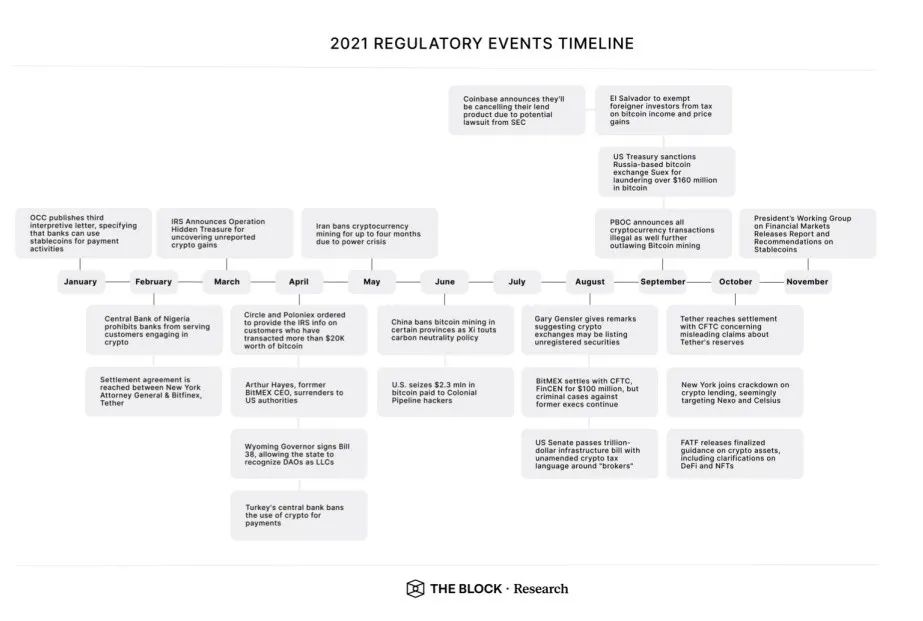
Mainstream Metaverse
NFT could serve as an early building block for Metaverse
NFT has experienced rapid growth over the past year, which has excited some and frustrated others. Once considered a small part of the overall cryptocurrency landscape, NFT has dominated mainstream discussion as many grapple with the idea of enabling digital property through token scarcity.
It has become a way of expressing cultural relevance for many companies that either decide to buy the currently popular non-functional documents or publish their own. Taco Bell kicked off the campaign in early March with the release of 25 Taco-themed NFTS, proceeds from which will benefit the Live Mas Scholarship. The response to their idea was positive, and NFTs sold out in 30 minutes.
Instead of launching its own line, Visa decided to announce the acquisition of CryptoPunk for $150,000 in August. As one of the first NFT series, CryptoPunks represents an important culture in the cryptocurrency community. Visa's acquisition announcement was accompanied by a white paper explaining the intersection of generic technology and traditional business. The decision by companies like Visa to publicly announce their support for this movement is an unprecedented moment in the convergence of traditional companies and the broader crypto landscape.
Other companies have decided to take the opposite view, with major gaming platform Steam announcing a direct ban on all games on its platform that include "blockchain technology" and NFT. Claims about the environmental damage caused by non-fibrous forestry techniques create an interesting polarisation between supporters and opponents.
NFT technology has revitalized the "art of trade" world
In an area where creators are often undercompensated for their contributions, the digital art scene experienced a resurgence in 2021, thanks in large part to the NFT boom.
Mike Winkelmann, better known as digital artist Beeple, is a longtime creator who has experienced some success in his career, but his fortunes changed completely when he entered the world of NFT. After 14 years of making what he calls "Everydays," he sold his first 5,000 "days" at Christie's for a total of $69.4m. This will be the first non-functional memory auction at auction, but it certainly won't be the last in 2021. Next month, Sotheby's will auction a series of works by Pak, a respected NFT artist, for nearly $17 million. In addition, Sotheby's has added cryptocurrencies such as ETH as auction currency.
In November, Sotheby's held a historic auction in which a signed original constitution sold for $43.7 million, the highest price ever paid for a constitutional document. While that effort was unsuccessful, Constitutional DAO raised more than $40 million to buy the document.
Naturally, the big crypto exchanges pay close attention to digital markets like OpenSea and Christie's (Christie & AMP; Sothebys and other traditional auction houses are scrambling to launch their own non-FT markets. Early last month, FTX announced a non-functional marketplace, while Coinbase, one of their biggest competitors, announced that their official non-functional marketplace would launch by the end of the year. Let's take a look at the pre-launch excitement for Coinbase NFT, with over 1 million unique users signing up for the wait list on the first day of launch.
Metaverse plays a key role in the company's roadmap
Before 2021, the term Metaverse was rarely used, having its origins in the 1992 science fiction novel Snowstorm. As digital communications apps like Zoom become more and more common in our daily lives, there is a broader discussion about what the evolution of these tools will look like.
The meta-universe tends to be defined differently depending on who you ask, but we summarize it as a paradigm shift in the way we interact digitally. By leading Metaverse analyst Matthew Ball, "Metaverse's massively scalable and interoperable web-based real-time rendering of 3D virtual worlds can be experientially synchronized and continuously efficiently delivered by an unlimited number of users with a strong sense of personal presence, while the continuity of data, such as identity, history, Rights, objects, communications and payments." In short, Metaverse is defined not by a single purpose-driven application like games, but by the shared world in which the entire online activity takes place.
The early stages of Metaverse will launch in 2021, and several major companies have said they will do significant RESEARCH and development in the area. Epic Games, the studio behind the success of Fortnite, has secured a $1 billion funding round to support its metaworld vision. This could be a defining moment for the industry, as developers and studios look to build similar plans into their long-term roadmaps. One company that has seen an unprecedented shift in its roadmap is Meta, formerly Facebook.
Calling it not just the next chapter for his company but "the next chapter of the Internet", Mark Zuckerberg has made it clear to the world what his company's main focus will be over the next decade. On the third-quarter earnings call, Mark told shareholders that they will spend $10 billion in 2021 alone on research work related to Metaverse's growth goals. In addition, the company expects to continue spending at this rate for years to come, while acknowledging the lack of profitability of such spending in the near term. Similarly, they have announced their intention to hire 10,000 more people in the European Union over the next five years to help realise this vision. With a complete rebranding, and a lot of money spent on building Metaverse, Meta represents the most ambitious quest by any company to date to bring a concept to life.
Other major players, such as TikTok, Twitter, Microsoft, and Disney, have recently announced their own plans in the areas of encryption, NFS, and meta-domain intersection. As enthusiasm for these three areas runs high, they are likely to be at the heart of what will define technology for the next decade.
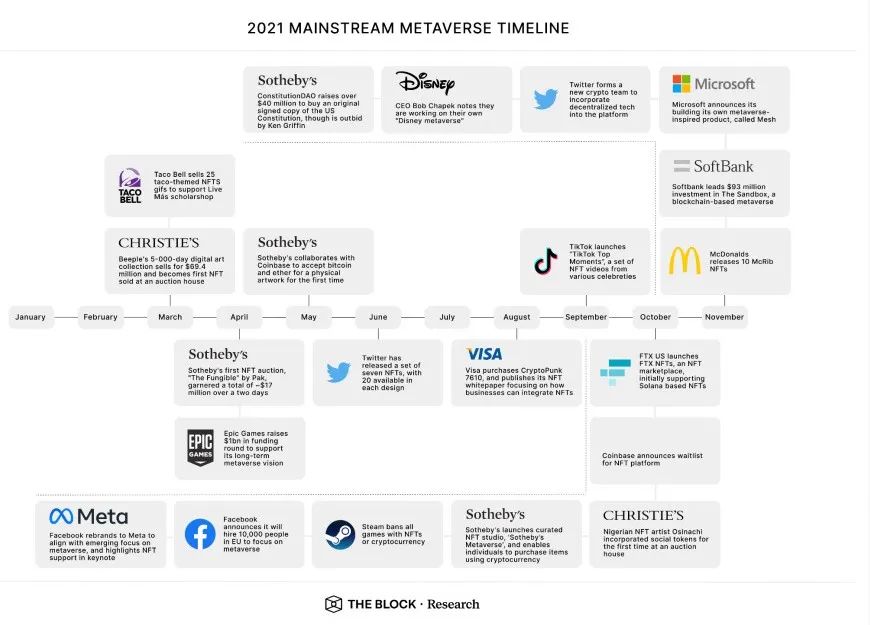
Economic data for 2021
This section provides an assessment of key economic trends emerging in each quarter of 2021.
Against this backdrop, we enter 2021 fresh from one of the most turbulent years in economic history. The pandemic of 2021 affected the legacy of the previous year, and the economic conditions that had developed worsened general uncertainty in the labor market, supply chain, and fiscal policy related to rising inflation. Despite these conditions, we are seeing a full recovery in all sectors of the economy, driven by confidence in the post-pandemic future.
One of the more predictive measures of our economy, the gap between long-term and short-term Treasury yields, has continued to trend higher from late 2020, suggesting that investors continue to believe in long-term market growth rather than short-term yields.

Similarly, a good assessment of macro conditions can be found in policy decisions regarding repo (repurchase agreement) operations. The Fed has been involved in helping to keep the federal funds rate within the Fed's target range since the New York Fed entered the repo market in September 2019 to help correct cash shortages at the cash and securities cross positions. Reverse repurchase agreement activity reached record levels in 2021 as the Fed continued to reduce its repurchase engagement.
In short, with so much cash sloshing around because of the massive expansion of the money supply over the past few years, financial institutions were eager to earn income from the piles of cash they otherwise had. With the Fed's repo business originally used to prevent a rise in interest rates that would hurt economic growth, the decision to engage in record reverse repos to prevent interest rates from falling too low was the subject of an ongoing battle between inflation fears and growth targets.

Reverse repurchase has not had a strong correlation with the cryptocurrency market, with total cryptocurrency market capitalization increasing from about $1.5 trillion to $2.9 trillion from mid-March to November (the same period when reverse repurchase activity surged).
The following sections outline key macro trends in GDP, consumer activity, and labor force participation for the first three quarters of 2021, with projections for the fourth quarter:
Q1 2021:
The recovery continued in the first quarter of 2021 as the real economy recovered and the government continued to provide assistance to households and businesses.
- GROSS Domestic Product: The U.S. real GROSS domestic product grew at an annual rate of 6.4 percent in the first quarter of 2021, according to the Bureau of Economic Analysis.
- Consumer confidence: As noted earlier, consumer confidence experienced a sharp recovery in the first quarter, reaching its highest level since the COVID-19 pandemic in 2020. That puts the consumer confidence index at 85%, its 20-year average.
- Consumer spending: Consumer spending accelerated 10.7% in the quarter, compared with 2.3% in the fourth quarter of 2020. A disproportionate share of consumer spending, which has been greatly boosted by recent rounds of stimulus, has seen a brief recovery.
- Labor force participation rate: Labor force participation has been a key focus for economists as we try to fully recover from severe job losses caused by the pandemic. The unemployment rate held steady quarter-on-quarter, averaging 6.2% on a seasonally adjusted basis.
In the first quarter of 2020, the crypto market increased 240% in total market capitalization and 155% in volume compared to the fourth quarter of 2020. The crypto market was capitalised at $760 billion by 2020 and $1.9 trillion by the first quarter of 2021. It's no surprise that cryptocurrency assets are doing well in the context of a full market recovery in the first quarter of 2021.
Q2 2021:
The second quarter was characterized by a continued return to normal with a slight increase in growth compared to the first quarter of 2021.
- GROSS domestic Product: The U.S. Bureau of Economic Analysis said the seasonally adjusted gross domestic product rose 6.5% in the second quarter, below economists' expectations of an 8.4% gain in the second quarter. There is also some concern among economists that the second-quarter GDP growth figures signal a slowdown in the economic growth environment.
- Consumer spending: Personal consumption rates were higher than expected, retail store openings increased, and public vaccinations steadily increased. The personal consumption rate came in at 11.8%, above expectations of 10.5%.
- Labor force Participation Rate: The labor force participation rate was essentially unchanged in the second quarter, which is part of the reason second-quarter GDP growth was slower than expected. The unemployment rate was 5.9 percent at the end of June
The total crypto market declined in q2, from $1.9 trillion at the start of the quarter to $1.4 trillion at the end of the quarter. Stocks peaked in May, but fell nearly 50% in two weeks, beginning a months-long rally.
Q3 2021:
The third quarter confirmed economists' concerns about a slowing growth environment, with delays in the launch of Delta variants and supply chain bottlenecks remaining an issue.
- GROSS Domestic Product: Real GROSS domestic product grew only 2 percent in the third quarter, and consumer spending generally declined compared to previous quarters.
- Consumer spending: Consumer spending rose just 1.6 percent in the third quarter, suggesting that the decline in spending accelerated as government stimulus spending ended.
- Labor Force Participation Rate: The labor force participation rate rose, and the unemployment rate hit a low of 4.8 percent at the end of September.
The crypto market continued to recover in q3, starting the quarter at $1.4 trillion and ending the quarter at $1.9 trillion. Compared to other asset classes, cryptocurrency markets have performed well and are relatively strong.
Fourth quarter 2021:
Although we are not yet at the end of the year, we can use forecasts through mid-November to guide our assessment of the quarter.
- GROSS domestic product: Expectations for the fourth quarter are quite strong compared to the less-than-stellar growth figures for the third quarter, helped by less worries about supply chain bottlenecks and excess household savings from previous government stimulus programs. Many leading analysts expect real GDP to grow at an annualised rate of 5% in the fourth quarter.
- Consumer spending: McKinsey analysts expect consumer spending to rise 7% in the fourth quarter from the fourth quarter of 2020, as consumers snap up holiday merchandise before retail inventories run dry.
- Labor Force Participation rate: The unemployment rate continued to decline in October, falling to 4.6%, indicating a return to normal in the labor market compared to previous quarters.
The cryptocurrency market has had a strong quarter so far, with total market capitalization surpassing its all-time high in November to reach around $3 trillion.
Backtest popular cryptic narratives of 2021 economic data
Cryptocurrencies as an inflation hedge
The macroeconomic environment in 2021, especially against the backdrop of increased central banks associated with expansionary monetary policies and fiscal spending, has brought renewed attention to the role of cryptocurrency assets as a hedge against inflation. Much of the attention has focused on bitcoin, given the predictability of its procedural monetary policy and its growing acceptance by private institutions and governments around the world. While bitcoin has been referred to as "digital gold" for some time, institutional investors have only recently begun to largely embrace the idea. As JPMorgan wrote in a note to clients in October, "Institutional investors appear to be returning to Bitcoin, perhaps viewing it as a better inflation hedge than gold."
The driving force behind this argument becomes even more apparent when you compare the growth in the supply of bitcoin with the growth in the Federal Reserve's balance sheet, and the resulting liquidity injection into the economy. Over the period since 2012, while the supply of bitcoin has increased by about half, the assets on the Fed's balance sheet have more than doubled. As the fiat money supply continues to grow, institutional investors seem increasingly attracted to Bitcoin's deflationary supply plan.
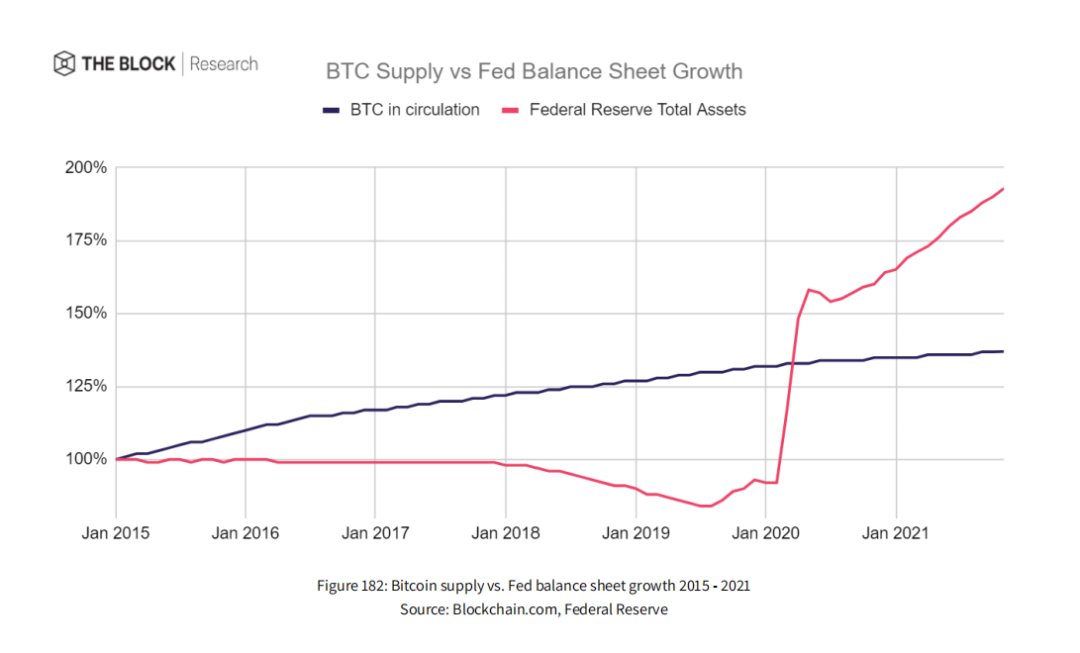
However, bitcoin's applicability as an inflation hedge is far from proven. Bitcoin has been around for just over a decade, so it hasn't been around long enough to measure performance during periods of sustained inflation. Gold, on the other hand, has been around for centuries as a reliable haven.
Some recent academic studies have demonstrated that bitcoin is an inflation hedge. In the only rigorous empirical study so far of the relationship between bitcoin prices and inflation, Choi and Shin of Yonsei University found that bitcoin performed well in inflationary events. However, Choi and Shin's findings challenge the idea that bitcoin should be seen as a "safe haven" asset similar to gold.
They found that bitcoin and gold react very differently to stock market volatility, with Bitcoin tending to react positively to rising stock market prices but negatively to periods of stock market volatility. In this regard, they found that gold was a better hedge against the stock market because prices reacted positively during periods of stock market volatility. Still, they caution about their findings, but the truth is that the available data for Bitcoin is still limited to the very early stages of the maturation of the crypto market in which we live.
The jury is still out on whether bitcoin can cement its position as a haven asset, but the continued adoption of the currency by institutions suggests growing confidence in its possibilities. Bitcoin's returns relative to gold and other assets have undoubtedly driven much of the interest in the cryptocurrency in recent years. The dollar's decline against stocks, commodities and bitcoin over the past year and a half illustrates the latter's appeal as an inflation hedge -- but past performance is not always a strong indicator of the future.
Bitcoin as a portfolio diversification vehicle
One argument related to Bitcoin as "digital gold" is that it serves as a vehicle for portfolio diversification. The crux of this argument is that Bitcoin and other cryptocurrencies are uncorrelated to other asset classes and therefore deserve to be included in a diversified portfolio. There is some truth to this. The correlation between bitcoin prices and traditional assets over the past three years has been fairly low, according to Morningstar, Inc. Of several traditional asset class benchmarks, bitcoin has the highest correlation with a broad U.S. stock market index. Even so, it is only weakly correlated, with a coefficient of 0.33. The correlation with bond and commodity benchmarks is even lower.

However, it's worth noting that the correlation between bitcoin prices and US equity benchmarks has been on an upward trend since 2020, suggesting a recent tightening of the relationship between the two asset classes. As such, gold is likely to remain a more powerful portfolio diversification tool, at least when it comes to hedging equity positions.

Block Research provides daily industry-leading Research and analysis covering a range of topics in the digital asset space. Our research and insights are trusted by institutional investors, traders, financial services professionals, digital asset and blockchain infrastructure service providers, regulators, policy makers and cryptocurrency enthusiasts, helping them stay the most knowledgeable in the market.
The original link
Welcome to join the official BlockBeats community:
Telegram Subscription Group: https://t.me/theblockbeats
Telegram Discussion Group: https://t.me/BlockBeats_App
Official Twitter Account: https://twitter.com/BlockBeatsAsia


 Forum
Forum Finance
Finance
 Specials
Specials
 On-chain Eco
On-chain Eco
 Entry
Entry
 Podcasts
Podcasts
 Activities
Activities
 OPRR
OPRR


